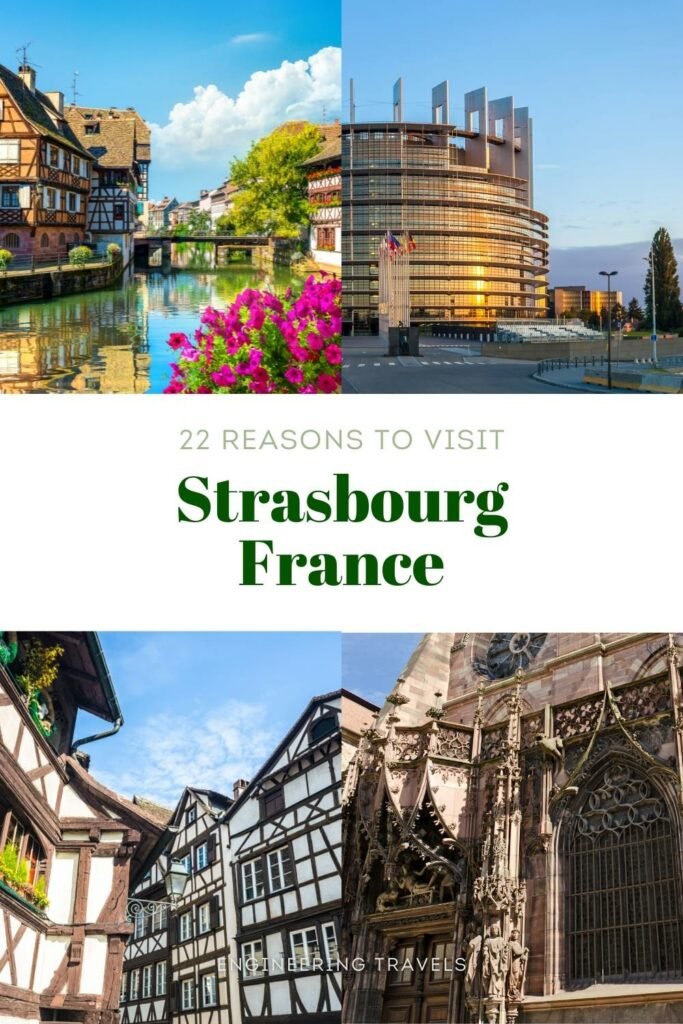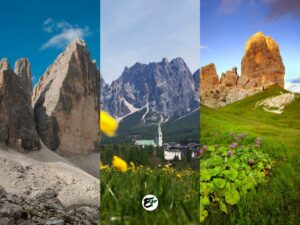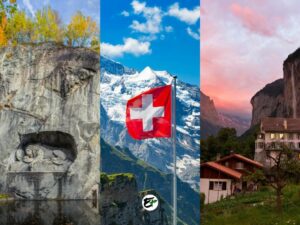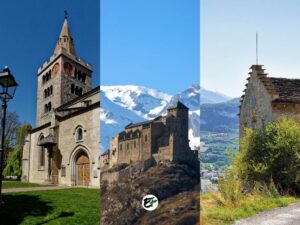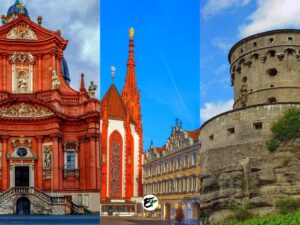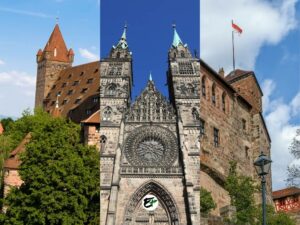The Ultimate Strasbourg Travel Guide: 22 Things to See & Do
One of the things that fascinates me about European cities is their profound history and diverse culture. These facets are intricately woven into the city’s fabric, and they come alive as you stroll through their streets. This is particularly true for Strasbourg, a city located in Alsace, Grand Est.
As a traveler from the other side of the world, where things are totally different, I can’t recommend Strasbourg enough as a travel destination.
Strasbourg, nestled along the French-German border, is a beautiful fusion of cultures — a cultural melting pot. It serves as a microcosm of Europe itself, a fact that becomes apparent as you explore its three distinct districts: Grande Île, Neustadt, and European district. Each district unveils unique attractions that echo tales from the past, romantic spots that stir the heart, and influential international institutions.
After spending days exploring and finding the hidden gems, I can tell you that Strasbourg is worth it for a plethora of new discoveries and unique experiences it offers.
This post contains affiliate links. I may receive a tiny commission at no additional cost to you.
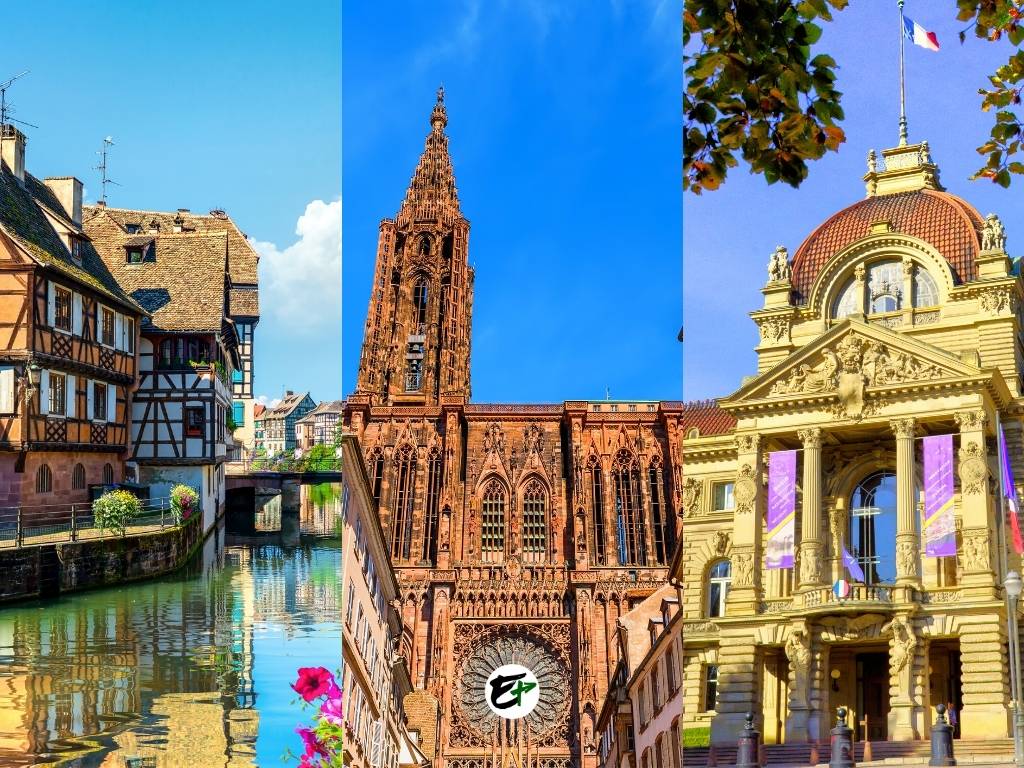
Use the table of contents to skip to topics.
With this article, I’ll take you on a virtual trip through Strasbourg. You’ll learn about its top sights, famous landmarks, hidden gems, and the many wonderful things it has to offer. I believe these are the reasons why every traveler should visit Strasbourg. I won’t just point out the sights, I’ll also give you useful info for your visit and links to the official websites of these attractions. Think of this post as your personal travel guide, showing you the best of what Strasbourg has to offer.
Before we get into details, here are some of the beautiful scenes awaiting you in Strasbourg.
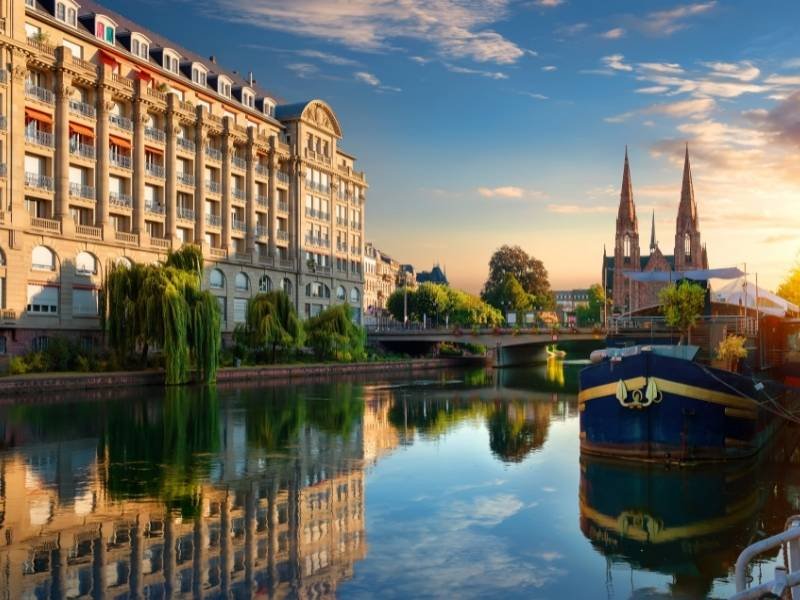
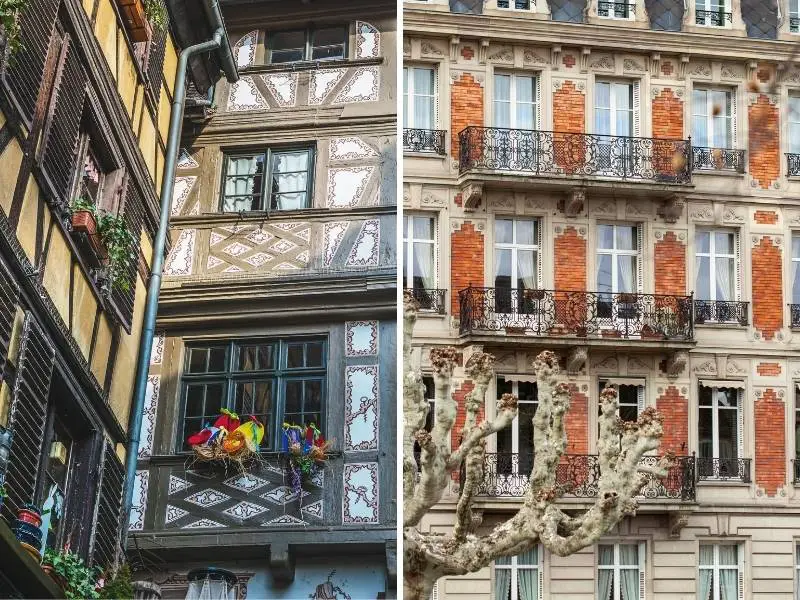
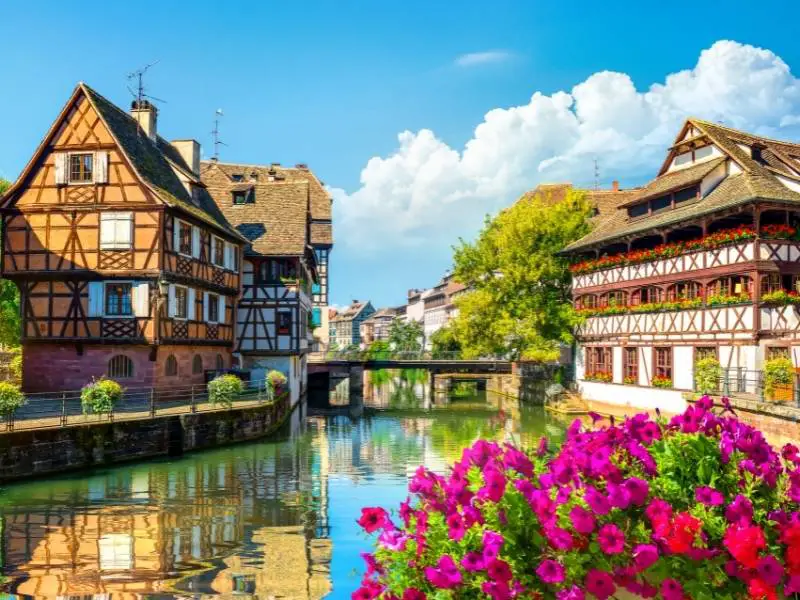
If you’re still looking for a place to stay, here’s a resource that can help you find the best hotel deals in Strasbourg.
1. Grande île
To me, the primary reason to visit Strasbourg is its historical center, known as Grande île. It’s one of France’s most interesting UNESCO World Heritage Site, epitomizing beautifully preserved medieval cities.
I’ve already seen several historical city centers in Europe, but there’s something special about the one in Strasbourg: It was built over a big island of a river. You don’t come across places like Strasbourg’s Grande île very often!
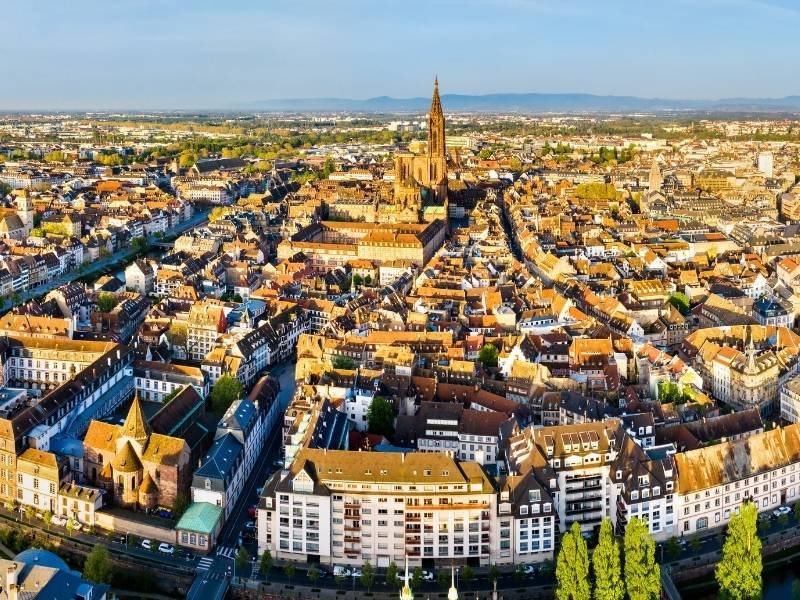
Honestly, when you’re in Grande île, it’s almost impossible not to get lost in its beauty and start taking pictures left and right. It’s packed with these huge squares, churches that have been around for centuries, and really impressive palaces and hotels.
Plus, there are these charming cobblestone paths, intricately decorated buildings, adorable houses, balconies bursting with flowers, lüftlmalerei, and flags of all colors. It feels like you’ve been transported centuries into the past.
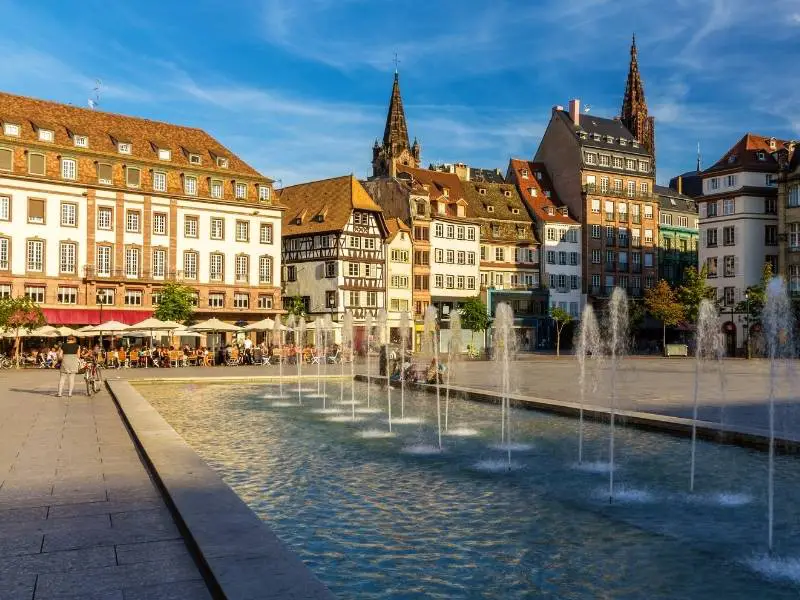
If you’re thinking about exploring Grande île, you’ve got to check out the Cathedral District. It’s this pedestrian-only area around the Strasbourg cathedral that really gives off that medieval vibe. There are a few squares in the district that you just can’t miss.
First up, you’ve got Place du Château. This is the spot in Strasbourg’s Grande île where you can catch a glimpse of the Strasbourg Cathedral’s awe-inspiring southern facade and the elegant French Baroque gate of Palais Rohan. It’s a sight to behold!
Then there’s Place de la Cathédrale. This place offers epic views of the main facade of the Strasbourg Cathedral, and it’s also home to the beautiful Maison Kammerzell restaurant.
Don’t forget about Place Gutenberg Square. Just a couple of blocks southwest of the Cathedral, this square is where you can admire the statue of Gutenberg—the guy who invented the printing press. You’ll also find the Neubau, a 16th-century building with a remarkable stone-cut symmetric design.
And last but not least, there’s Place Kléber. This is the main square of Grande île, and it’s where you’ll find the Christmas Market in December. It’s got everything from the L’Aubette shopping mall to lovely fountains and coffee shops (yes, there’s a Starbucks).
2. The Strasbourg Cathedral
Right in the heart of Grande île, there’s this amazing structure you just can’t miss when you’re in Strasbourg. It’s the Strasbourg Cathedral, and it’s one of the main reasons people visit the city. Why, you ask? Well, it’s the sixth-tallest church in the world! The cathedral’s single spire reaches up to 142 meters or 466 feet, making it a dominant feature in Grande île’s skyline.
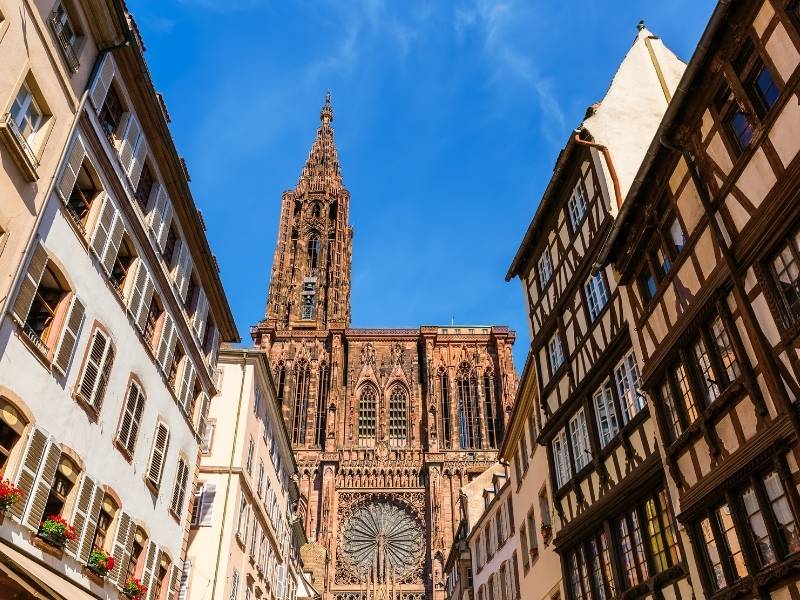
Did you know that the Strasbourg Cathedral was the tallest structure in the world for over 200 years, from the mid-17th to the late-19th centuries? It’s a masterpiece of Rayonnant Gothic architecture, which is one of the reasons it’s a must-visit when you’re in Strasbourg.
Even Victor Hugo, the famous French poet and novelist who wrote The Hunchback of Notre Dame and Les Misérables, called it a ‘gigantic and delicate marvel.’
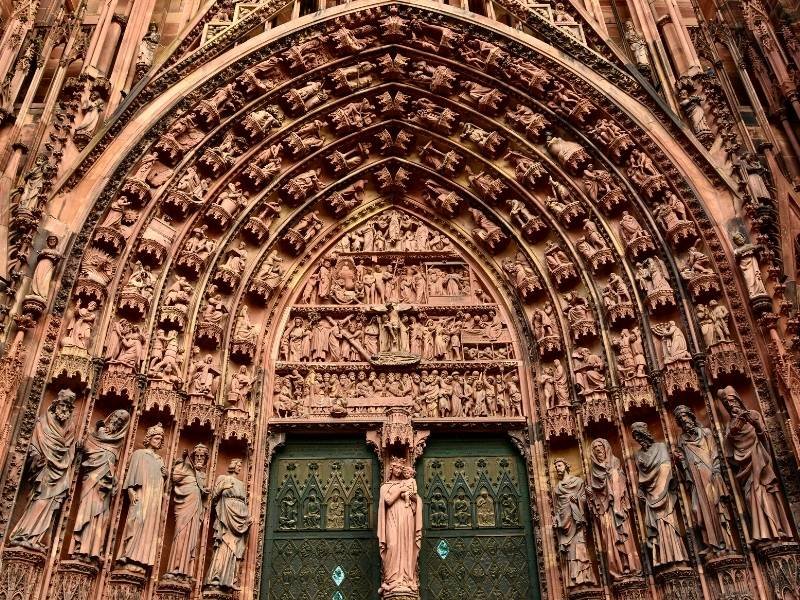
You won’t believe the level of detail on the Strasbourg Cathedral. It’s got this spire that’s so intricate it’ll make your head spin, not to mention its rose window, portals, and even the balustrade. But the real showstopper? The portals. They’re decorated with these beautiful sculptures that depict Christian and biblical stories, offering a window into what matters to the people in Strasbourg.
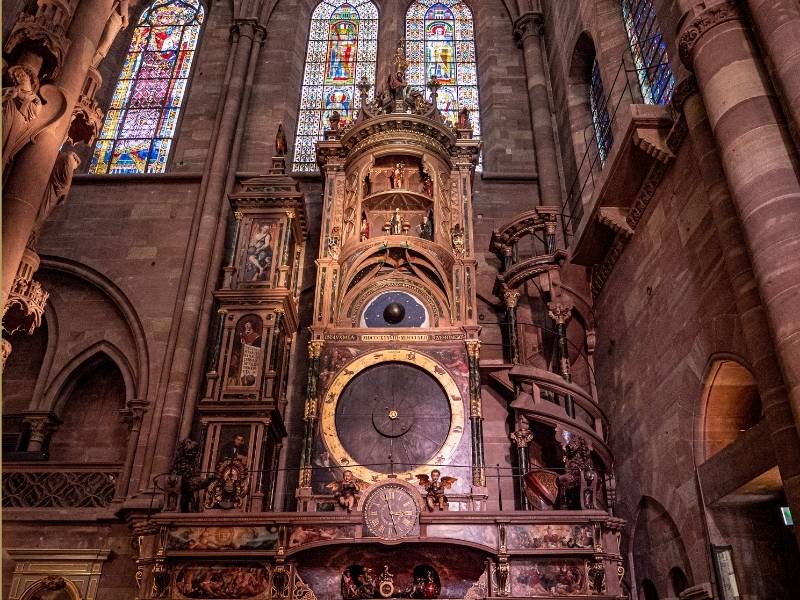
The sculptures on the portals of the Strasbourg Cathedral are like a storybook in stone. They depict tales like the Wise and Foolish Virgins, the Battle of the Vices and Virtues, and even the passion and resurrection of Christ. It’s a sight that’s truly a gem to behold. But the awe doesn’t stop at the cathedral’s exterior. Once you step inside, you’ll find that the interiors of the Strasbourg Cathedral are just as breathtaking.
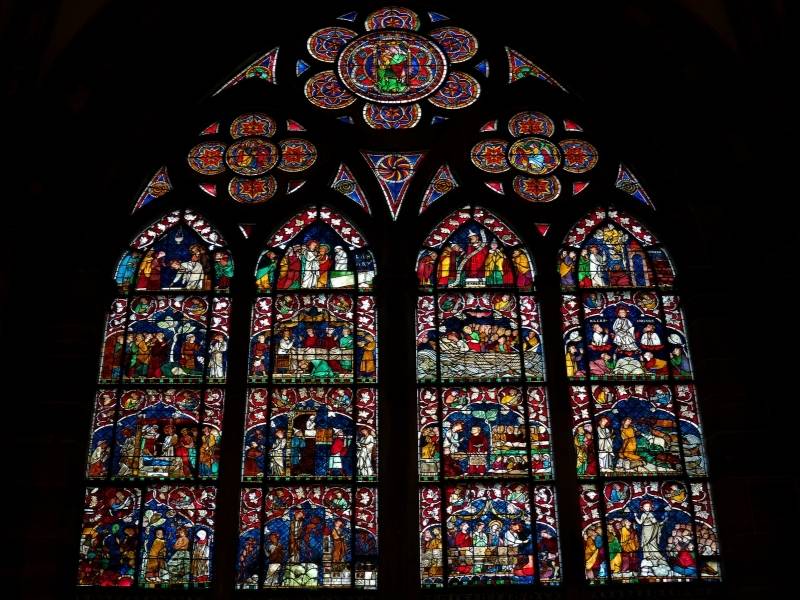
The Strasbourg Cathedral is packed with artistic and architectural wonders. You’ve got tapestries that depict biblical stories and Byzantine-style mosaic paintings on the cathedral’s apse. If you’re into old art and architecture, these artworks alone could be your reason to visit Strasbourg.
And you won’t believe the astronomical clock inside! It’s been impressing visitors since the 14th century with its celestial globe, mechanically animated characters, and more. Keep an eye on it – it does something new every 15 minutes!
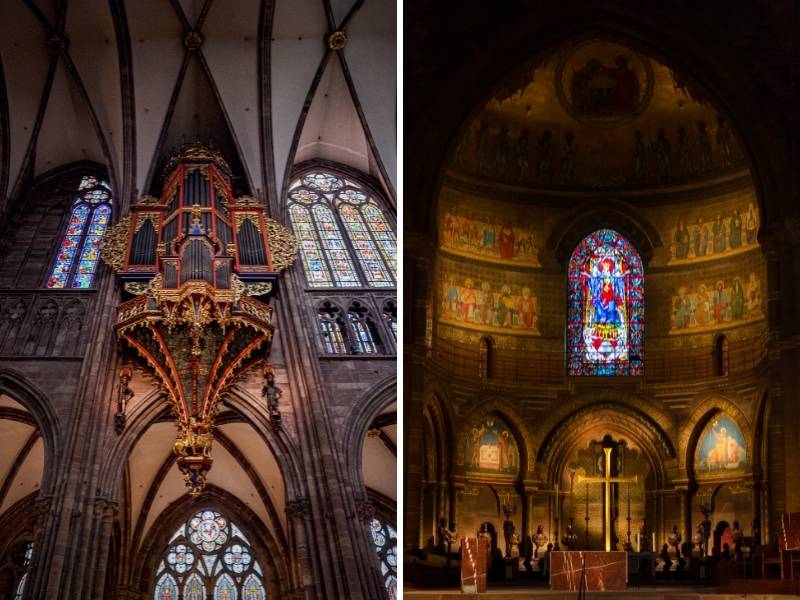
And let’s not forget about the stunning 12th-century stained glass in the nave. It’s like a kaleidoscope of colors, depicting emperors and kings from Swabia and Bamberg, Germany. The stained glass in the cathedral’s north transept is also worth a mention, with scenes of the Judgement of Solomon, Saint John the Baptist, and Saint John the Evangelist.
If you really want to be blown away by intricate ornamentation, you’ve got to check out the pulpit. It’s covered in decorations, from colonettes and gables to sculptures of Christ, Mary, Kings, and other Church icons.
swipe the 360° image below to see more views
The best part about the Strasbourg Cathedral? It’s free to enter! You can visit anytime between 8:30 am and 5:45 pm from Monday to Saturday, but they do take a lunch break from 11:15 am to 12:45 pm. On Sundays and holidays, the cathedral is open from 2:00 pm to 5:15 pm. And if you’re up for it, you can climb up to the Cathedral’s roof platform for a small fee. The view of Strasbourg and the cathedral’s copper rooftops is totally worth it!
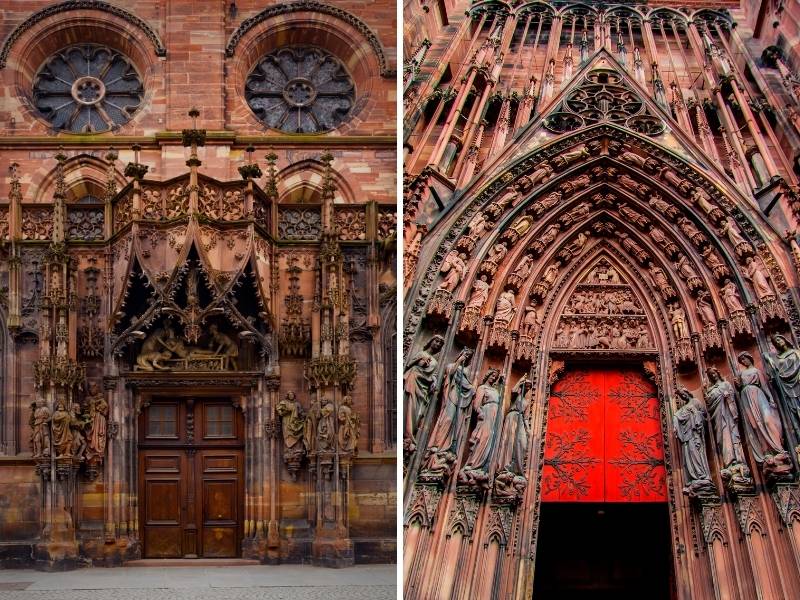
Want to know exactly where to find Strasbourg Cathedral in Grande île? I can help with that: exact location of Strasbourg Cathedral. And if you’re after more details, the official website of Strasbourg Cathedral is a great resource.
Are you into impressive churches? Then you can’t miss Reims. It’s got this cathedral that’s steeped in history – it’s where the French Kings were crowned for centuries!
3. Palais Rohan
One of the things I love about Strasbourg is that you don’t have to go far to see another stunning piece of architecture. Take Strasbourg Cathedral and Palais Rohan, for example. They’re just a stone’s throw away from each other!
Palais Rohan, like the cathedral, is a must-see when you’re in town. It’s considered one of the finest examples of 18th-century Baroque architecture in France, designed to mirror the elegance of Parisian palaces.

Did you know that Palais Rohan was actually the home of the prince-bishops of Strasbourg from the House of Rohan? That’s where it got its name. And ever since it was finished in the late 1700s, it’s welcomed not only the Rohan royals but also notable personalities like King Louis XV and Emperor Napoleon.
There’s something special about standing in the same spot where these influential people once stood, seeing what they saw all those centuries ago, don’t you think?
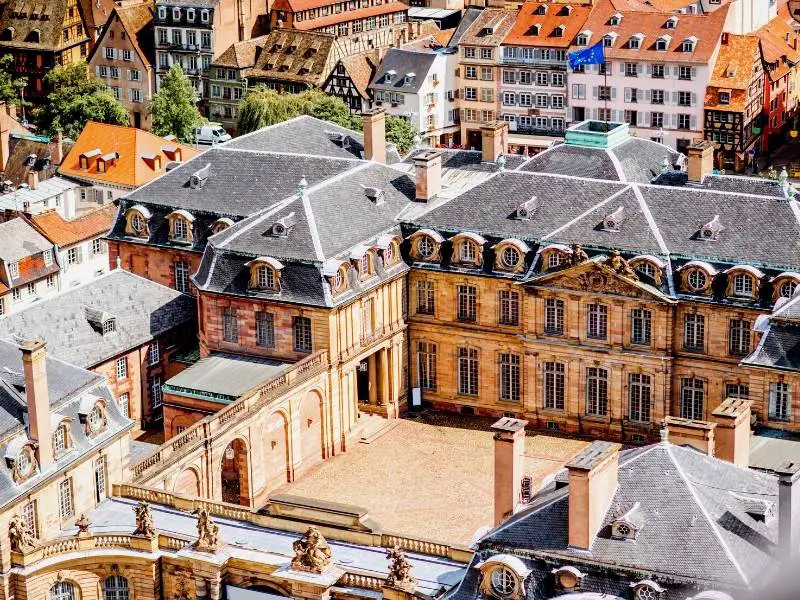
I didn’t pick Palais Rohan as a top spot in Strasbourg just because of its architectural beauty. It’s what’s inside that really counts. Would you believe there are three museums housed within Palais Rohan? And these aren’t just any museums – they’re among the most significant museums in all of Strasbourg.
They are the Archaeological Museum is located in the basement of the palace; the Museum of Decorative Arts stays on the ground floor of the palace; and the Museum of Fine Arts is situated on the first and second floors of the palace.
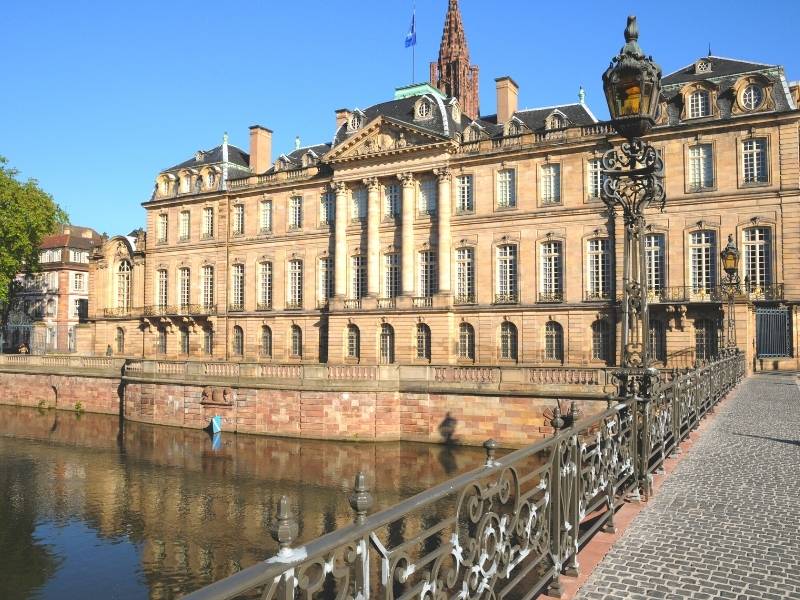
Here’s a quick summary of the visiting information of the museums inside Palais Rohan:
- Opening hours: 10:00 am to 6:00 pm, all week side from Tuesday.
- Admission fee: 7.5 EUR/adult/museum. You can check this page to see if you can avail of discounts or free admission.
Palais Rohan isn’t the only palace worth checking out in France. Over in Avignon, you’ll find Palais des Papes, the largest gothic palace in all of Europe. Back in the 14th century, it was actually where the popes called home.
4. Kammerzell House
Earlier, I mentioned that many of Strasbourg’s stunning sights are just a few steps apart. That’s certainly true for Kammerzell House, which you’ll find in Place de la Cathédrale, right next to Strasbourg Cathedral.
Kammerzell House is another must-see in Strasbourg. Its architecture is something to behold, and it’s not just for architecture buffs – it’s the kind of place that can impress just about anyone.
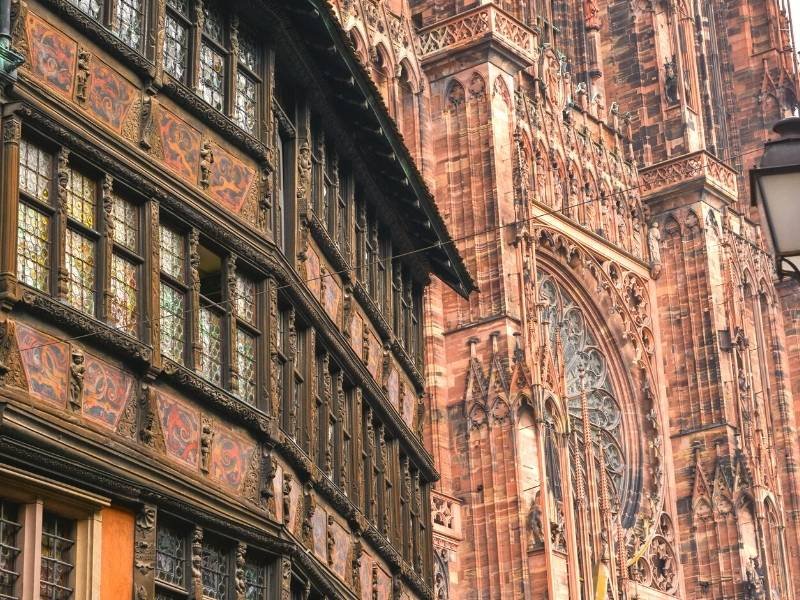
Kammerzell House’s intricate wooden sculptures, vibrant paintings, and unique honeycomb-like bottle-bottom stained glass windows are something you won’t want to miss when you’re in Strasbourg. Definitely, it is one of the most elaborate examples of late Gothic Architecture you’ll ever come across in Strasbourg.
Patricia Schulz even mentioned Kammerzell House as one of the world’s best brasseries in her book ‘1000 places to see before you die.

You bet! Kammerzell House isn’t just a feast for the eyes – it’s also a restaurant that can satisfy your taste buds. I haven’t had the chance to dine there myself, but from what I’ve heard, the food presentation is Instagram-worthy.
And guess what? Kammerzell House also offers hotel accommodations. Once you step inside, you’ll be greeted by interiors adorned with lavish frescoes by the Alsatian painter Léo Schnug.
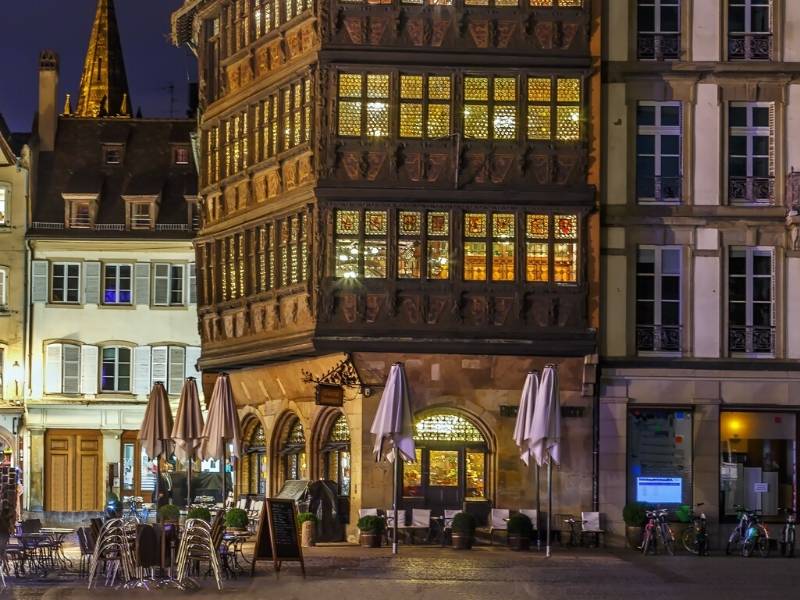
Interested in booking a night at their hotel or grabbing a table at their restaurant? You can make your reservations through the official Kammerzell House webpage.
5. Saint Thomas Church
As you stroll around Strasbourg’s Grande île, you’ll come across a host of stylish buildings. There’s no shortage of churches of different religions on the island either! Strasbourg is a real cultural melting pot, and even though these different cultures didn’t always see eye to eye in the past, today they exist side by side.
A perfect example of this is Saint Thomas Church, another landmark enough to be reason to visit Strasbourg. It’s the cathedral of Protestantism in Alsace and the region’s only ‘hall church’ (a church where the naves and aisles are the same height).
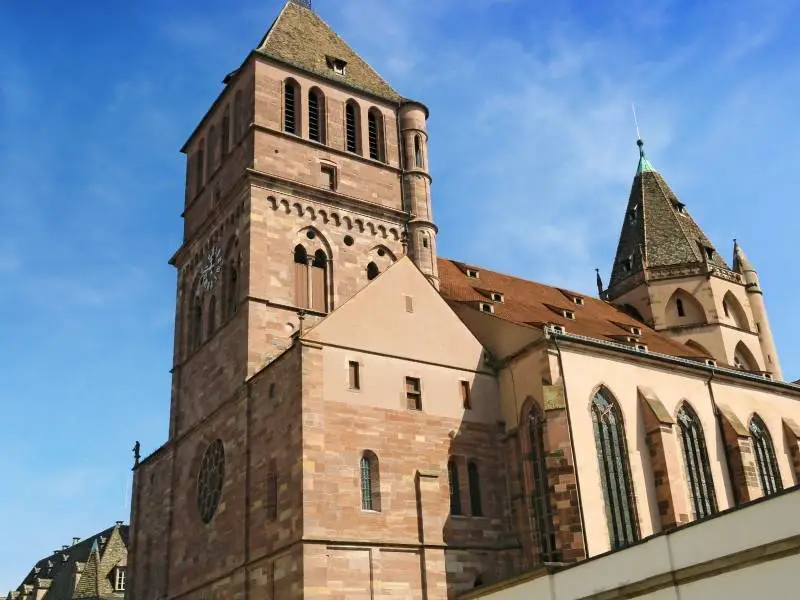
For me, Saint Thomas Church is a reason to visit Strasbourg mainly because of the mausoleum of Marshal Maréchal de Saxe–a beautiful example of 18th-century baroque funerary art. It’s one of the most unique discoveries you can have as you explore Eastern France.
Jean-Baptiste Pigalle, a renowned sculptor, crafted the mausoleum of Marshal Maréchal de Saxe. His artwork depicts death, glory, and power through ensembles like a lion, Hercules, etc.
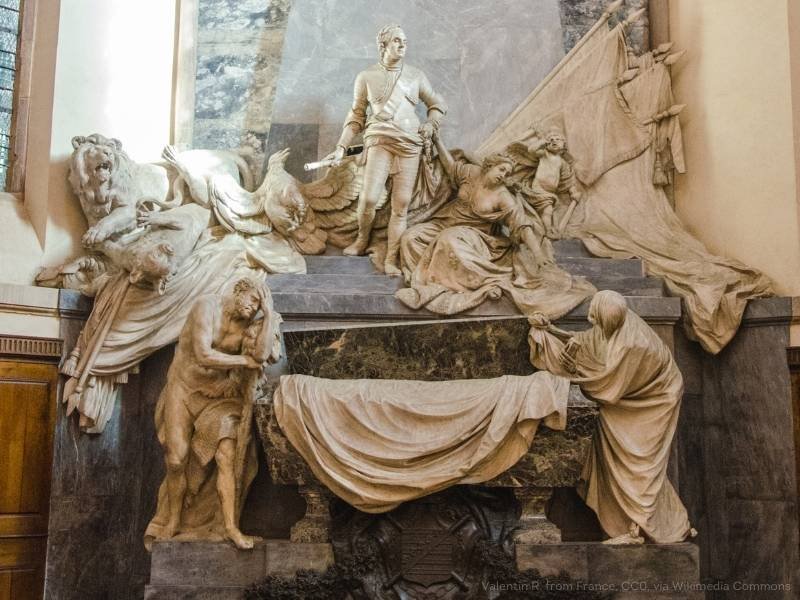
There are concerts often held inside Saint Thomas Church. Learn their schedules from its official website.
Saint Thomas Church is open to visitors throughout the week. You can drop by anytime from 10:00 am to 5:00 pm, Monday to Saturday. On Sundays, the church is open from noon to 4:30 pm. Just a heads up, though – you won’t be able to explore the church during mass services.
6. Historical Museum of the City of Strasbourg
If you’re the kind of traveler who loves to dive into the nitty-gritty details of your destinations, Strasbourg won’t disappoint. You’ll find a wealth of information all in one place!
Sure, the landmarks in Strasbourg tell a lot about the city, but if you want to really get into the specifics, the Historical Museum of Strasbourg is your go-to spot. It’s conveniently located just south of the Cathedral, right by the Ill River – just a 2-minute walk away.
The Historical Museum of Strasbourg is like a time capsule of the city’s past. It’s packed with collections that delve into every aspect of Strasbourg’s history, from politics and culture to economics and social life. There’s so much to discover!
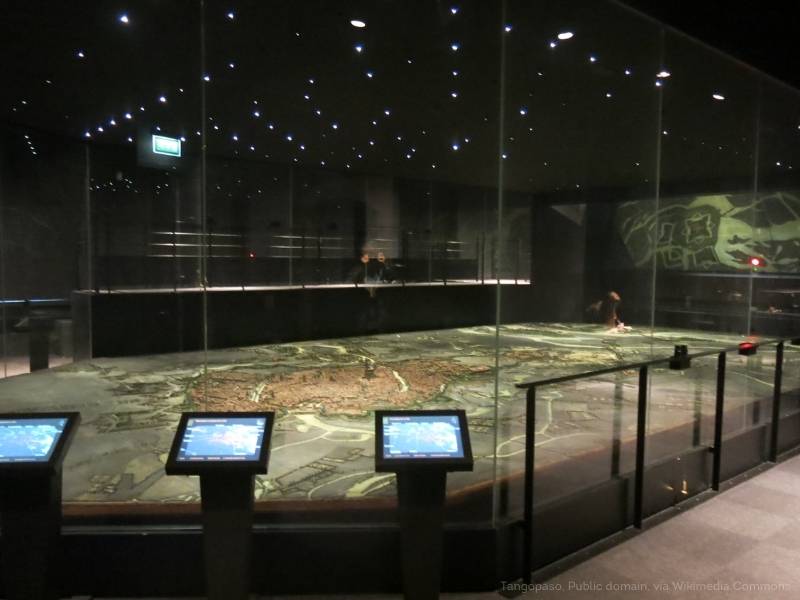
Have you ever wondered what life was like in Strasbourg from ancient times to the formation of European institutions? Well, the Historical Museum of Strasbourg is your answer! It’s packed with artifacts from different eras – think unique costumes of ordinary citizens, military weapons and uniforms, paintings, furniture, and a whole lot more.
It’s like stepping into a different world with each exhibit. You’ll discover so many aspects of life in Strasbourg!
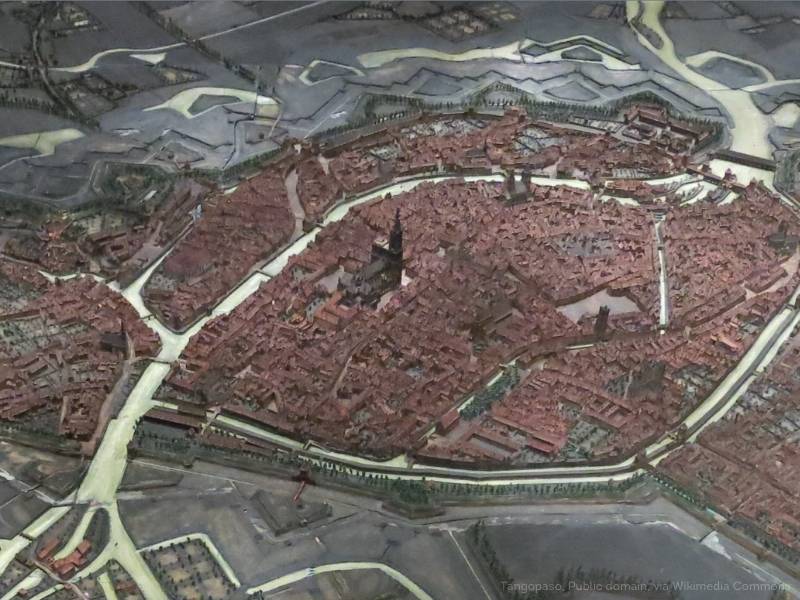
You won’t believe what I discovered at the Historical Museum of Strasbourg – a plan relief of the city and its surroundings from way back in 1727!
The detail on the miniature Strasbourg Cathedral is just mind-blowing. If you ever visit, don’t forget to bring your smartphone with the Google Earth App installed. It’s fascinating to see the contrast between Strasbourg now and how it appeared 300 years ago.
Thinking about checking out the Historical Museum of Strasbourg? It’s open every day except Monday, from 10:00 am to 6:00 pm. The entry fee was just 7.5 EUR per adult the last time I checked. And don’t forget to check the official website of Strasbourg Museums for any special announcements or discounts!
7. Petite France
Ever felt the need to escape from reality? Strasbourg is the perfect place for that! Imagine immersing yourself in magical scenes that make you forget about your everyday life. You might think, ‘But it’s a city, aren’t fairy tales usually set in the countryside?’
Well, Strasbourg might be a city, but it’s also the capital of Alsace, the most German region in France. So, who’s to say you can’t live out your fairy tale fantasies right here?
Did you know that Germany is often called the land of fairy tales? It’s where many of our beloved stories like Snow White, Hansel & Gretel, and Sleeping Beauty by the Grimm Brothers were born.
Now, you might be thinking, ‘But Strasbourg doesn’t have any castles!’ True, but have you heard of Petite France? Its charming buildings, quaint streets, and flower-decked river railings all give off that magical fairy tale vibe. Even Forbes agrees that Petite France is straight out of a fairy tale!
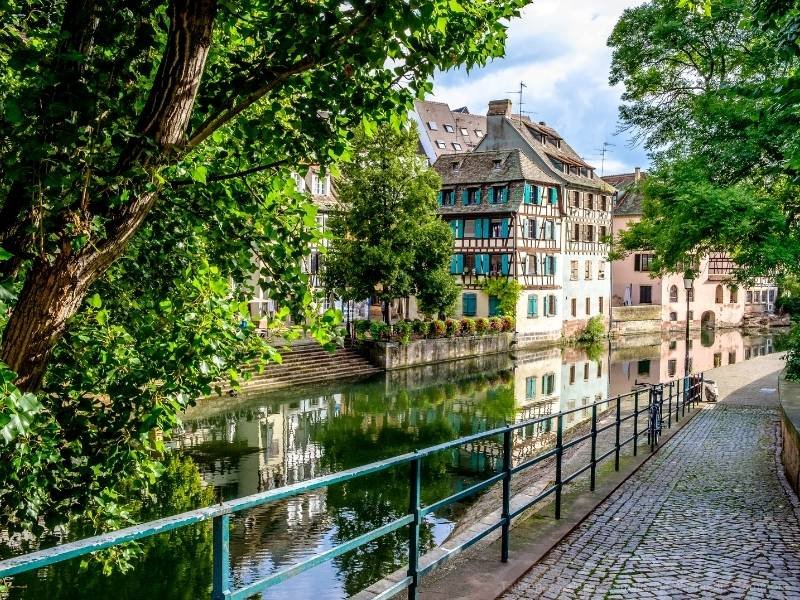
Curious about Petite France? It’s a historic quarter nestled in the western part of Grande Île. The River Ill flows through several canals here, making it an ideal location for tanners, millers, and fishermen to build their homes.
With its romantic and charming look, Petite France is undoubtedly a reason to visit Strasbourg. Stick around, and I’ll tell you more about what this part of Strasbourg has to offer!
8. The half-timbered houses in Petite France
The half-timbered houses in Strasbourg’s Petite France are straight out of a fairy tale!
They remind me so much of Warcraft, a game I used to play back in college. If you’re familiar with Warcraft, you’ll probably see the similarities between the homes of the game’s human characters and the houses in Petite France. I wouldn’t be surprised to know if Strasbourg and its neighboring towns and villages were what inspired the game designers.
This thought hit me when I discovered Rothenburg ob der Tauber in Germany. Like Strasbourg and Colmar in the Alsace Region, Rothenburg is another enchanting town that feels like it’s been lifted from the pages of a fairy tale.
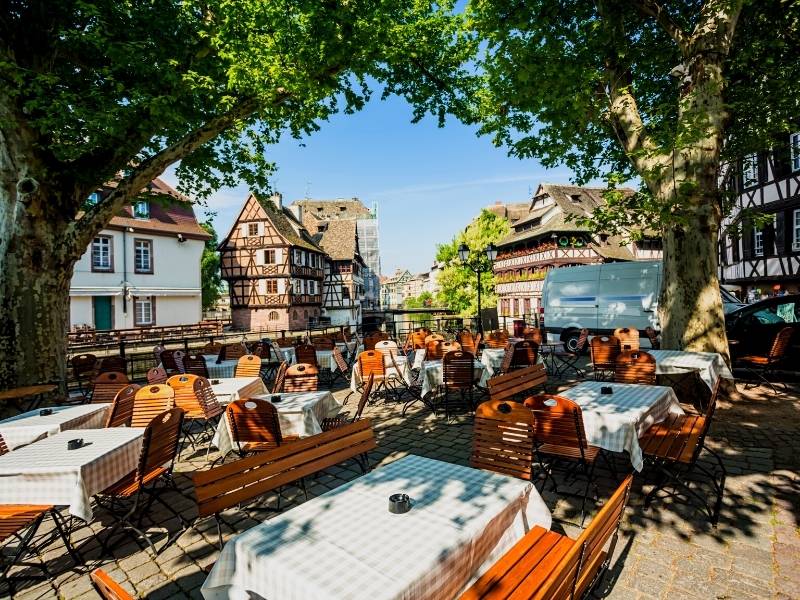
Anyhow, the timber patterns on these white or pastel-colored houses are simply mesmerizing!
They’re the kind of scenes that make you want to keep clicking that shutter button. Trust me, a stroll among these houses could be one of the most enchanting walks of your life. And if the weather’s on your side, you might even catch the beautiful reflection of these half-timbered houses in the calm Ill River.
Looking for the best views in Petite France? Let me tell you about a couple of spots.
First up, there’s Rue du Bain-aux-Plantes. This street is home to the white half-timbered houses that Strasbourg is famous for. It used to be a tanners’ street, and you’ll notice that the houses here are a bit different from others in Petite France – they have extra roofs that were used for drying animal skins.
Then there’s Place Benjamin Zix. This square is arguably the most picturesque spot in Petite France. From here, you can admire the white half-timbered houses of Rue du Bain-aux-Plantes and their reflections in the Ill River. Plus, in the summer, you can enjoy alfresco dining under the trees.
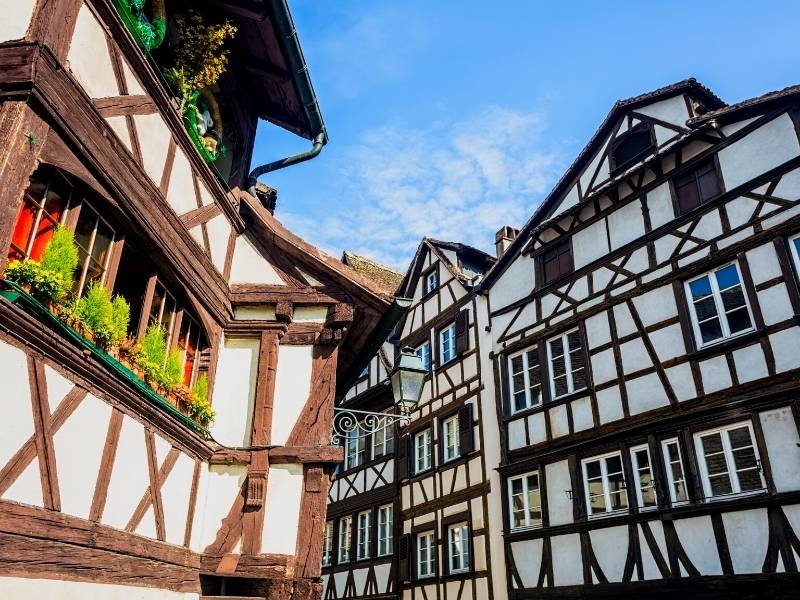
9. Ill River
Strasbourg isn’t just for lovely walks, it’s also perfect for a boat trip on the Ill River. Sure, it might not be as romantic as Venice, but it’s got its own unique charm that makes it worth a visit.
Why, you ask? Well, the Ill River winds its way through all the stunning districts in Strasbourg – Grande île, Neustadt, and the European districts. And a boat ride tour offers you a chance to discover this European Capital from a whole new perspective.
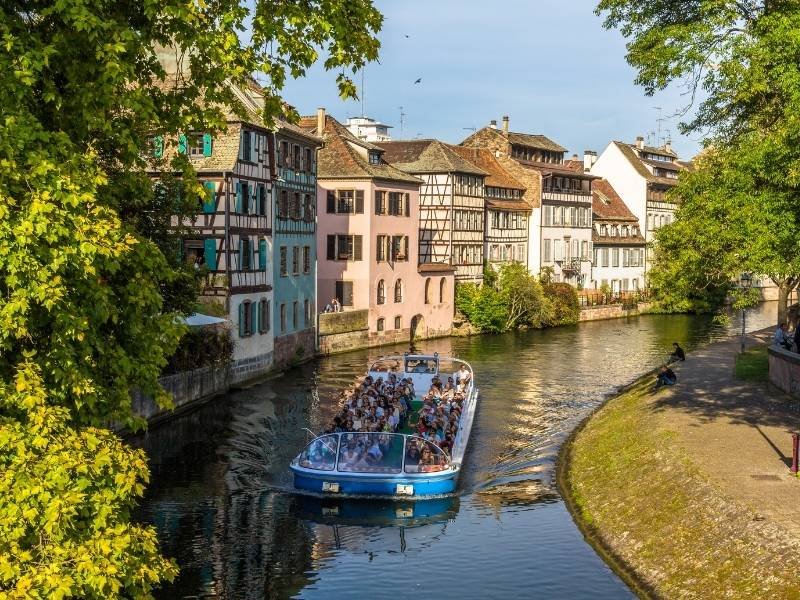
If you’ve only got a day to spare in Grand Est or Alsace, you absolutely have to try the boat tour.
It’s a fantastic way to see most of Strasbourg in less than half a day – the whole trip only takes 70 minutes and it’s available all year round. The tour is run by Batorama, and they provide audio guides on the boat so you can learn about all the different landmarks in Strasbourg. And don’t worry about the weather – the cruise is air-conditioned, so you’ll be comfortable no matter what.
During the boar ride, you’ll glide under stone bridges, past colorful half-timbered houses, medieval structures, picturesque churches, modern buildings, and so much more! Starting the boat tour from Grande île and ending in the European District feels like time traveling from the past to the future.
10. The Bridges in Petite France
When the River Ill reaches Petite France, it splits into several channels, each one lined with charming half-timbered houses. And the bridges over these canals? They’re a sight to behold!
If you’re traveling with your special someone, these bridges could be the budget-friendly romantic spot you’ve been searching for. They’re so picturesque, they could be straight out of a romantic movie scene.
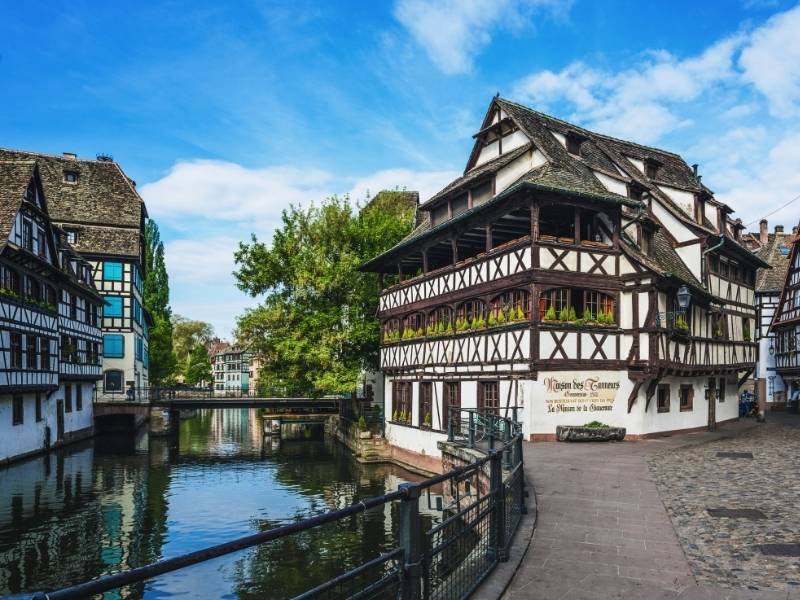
Imagine standing on a bridge surrounded by charming houses, with boats gently passing underneath and flowers hanging from the railings. It’s the kind of beauty that could make you open up and share your deepest feelings.
And just wait until you see it during the golden hour! Or in spring, when the bridges are adorned with colorful blooms. It’s like the whole place was designed for that dreamy marriage proposal!
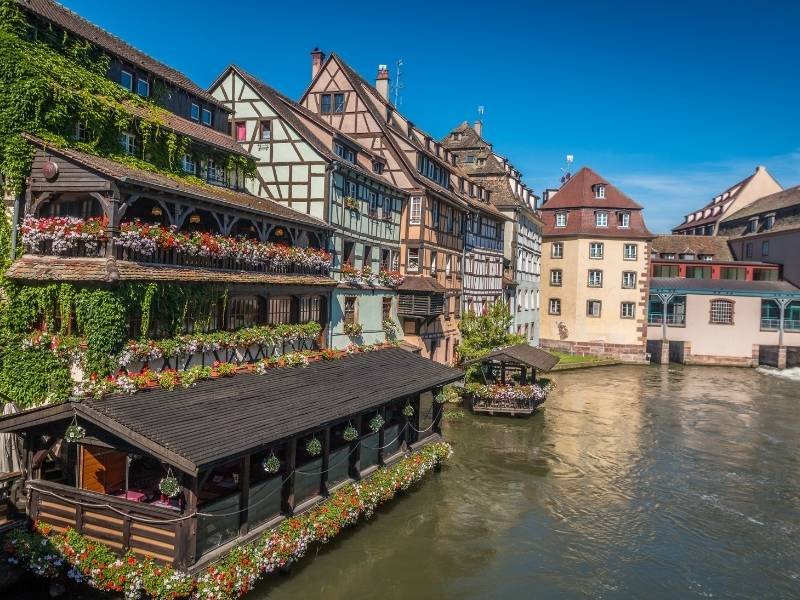
Among the bridges in Petite France, two really stand out for their stunning views – Pont du Faisan (as labeled by Google Maps) and Pont Saint-Martin. They’re conveniently located close to each other, connected by the charming Rue des Moulins street.
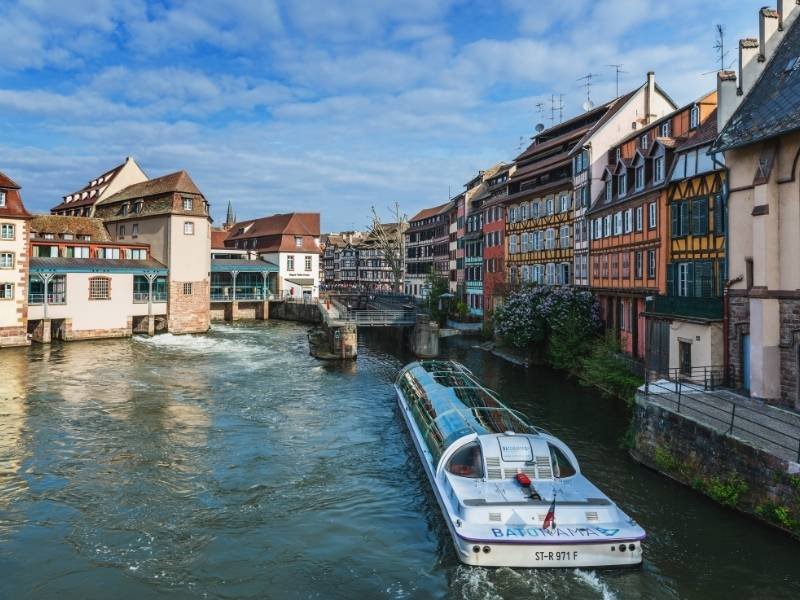
Just a few steps away from Place Benjamin Zix, you’ll find the quaint Pont du Faisan. Don’t let its small size fool you – this impressive hydraulic bridge has been around since 1888 and still opens up for passing boats!
A little further along, you’ll come across Pont Saint-Martin. This stone bridge offers a fantastic view of Au Pont Saint-Martin, a charming riverside restaurant that’s often adorned with beautiful flowers. From here, you can also see The Lock of the Old Glaciers and several pastel-colored half-timbered houses.
11. Ponts Couverts
In Petite France, Strasbourg, you’ll find bridges that seem to transport you back in time. One such example is the Ponts Couverts, nestled in the southwest corner of Petite France where the branches of the Ill River converge.
What makes Ponts Couverts a must-visit landmark is its unique location, shaped by the topography of Petite France. Plus, it’s a historical structure that dates back to the 13th century. Standing on these bridges, you’ll get a glimpse of what the European capital might have looked like hundreds of years ago.
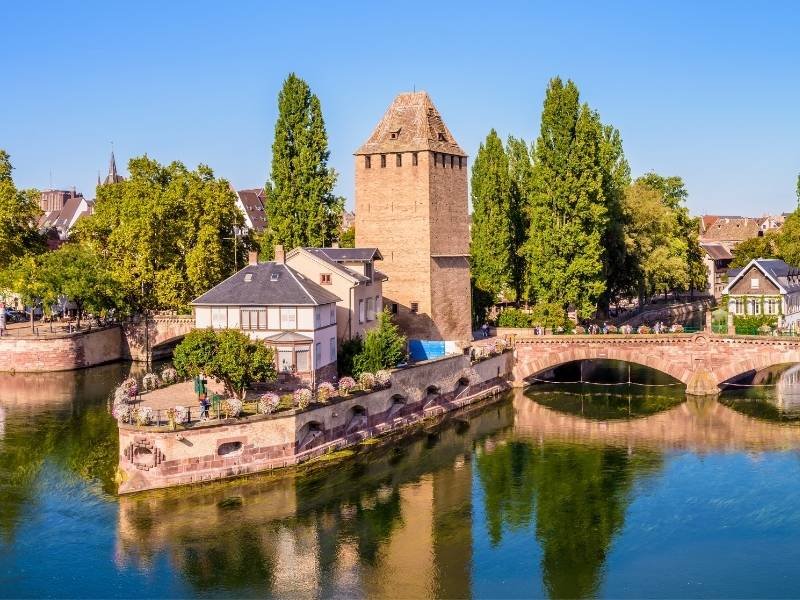
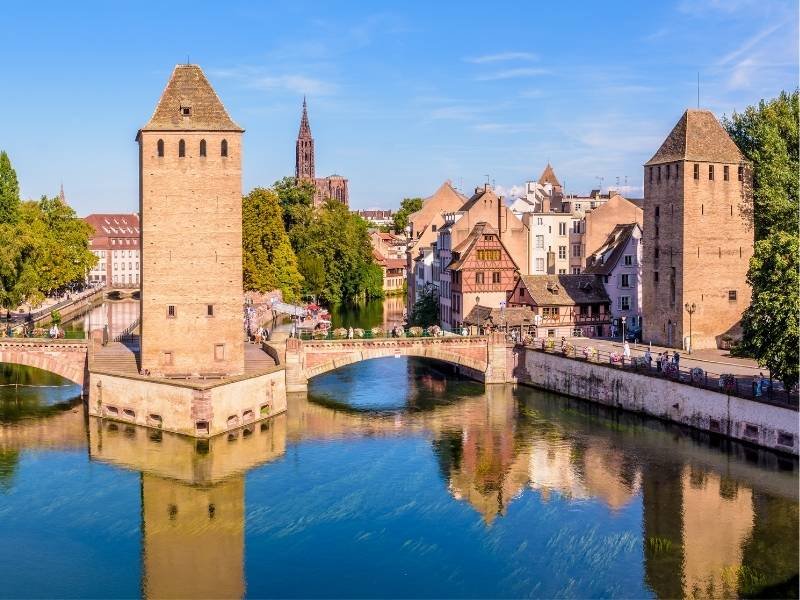
The historic Ponts Couverts in Petite France are more than just bridges. They’re also home to defensive towers that might remind you of those medieval movies you’ve seen on Netflix. As you walk closer to the towers of Ponts Couverts, you’ll notice features of its defensive architecture, like arrow slits. Just imagine arrows flying out and raining down on Strasbourg’s enemies during an attack.
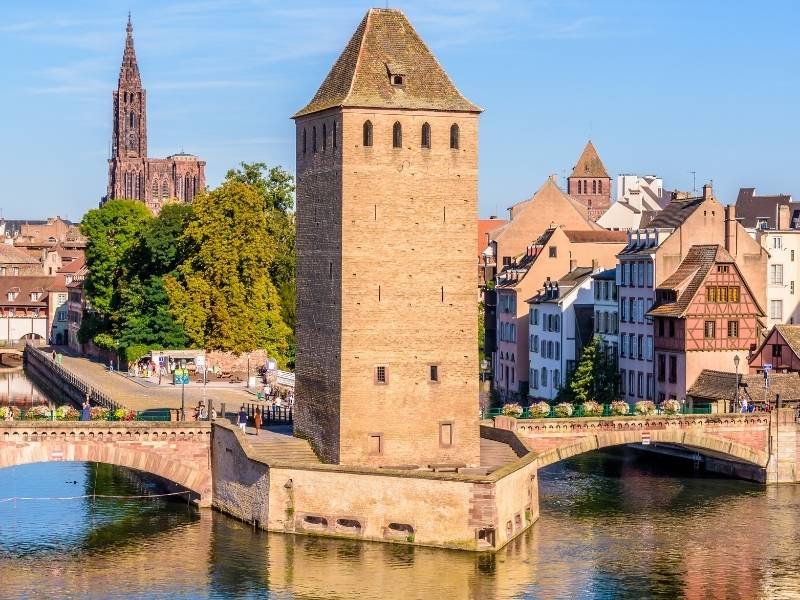
Here’s a fun fact for you! Did you know that Strasbourg once had medieval ramparts with a total of 90 towers, and Ponts Couverts was just a part of it? Up until 1784, Ponts Couverts even had roofs to protect the city’s defenders from enemy arrows – hence the name.
Today, it’s a fantastic place for a leisurely stroll and some photography. And if you’re looking for that perfect Instagram shot, check out the little house called Protection des Mineurs, nestled between Heinrichsturm and Hans von Altheimturm, the two towers in the central part of Ponts Couverts.
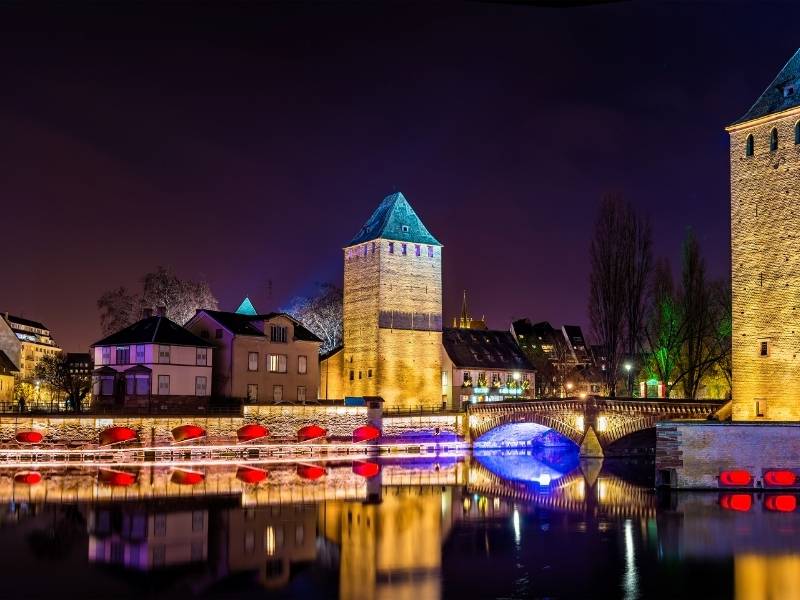
The garden of Protection des Mineurs is actually connected to Ponts Couverts and when spring or summer rolls around, the garden bursts into a sea of purple blooms. The sight of the quaint house with its beautiful garden is truly idyllic and something you won’t want to miss!
12. Vauban Dam
Just across the Ill River from Ponts Couverts, you’ll find another historic landmark in Strasbourg – the Barrage Vauban or Vauban Dam. From here, you can take in a stunning view of the Strasbourg skyline, with the majestic Ponts Couverts front and center.
But the Vauban Dam is more than just a great photo spot. It’s also a testament to the engineering prowess of the people of Strasbourg and their determination to defend their city; a reason to visit Strasbourg.
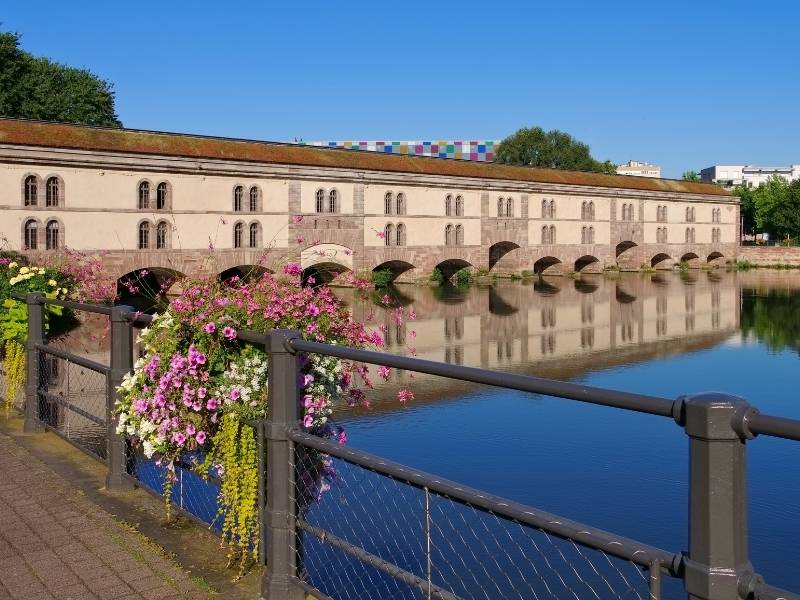
Interestingly, the Vauban Dam served as a crucial line of defense for Strasbourg. From 1690 until it was no longer needed, it shielded the city from potential invaders. It earned the nickname ‘Great Lock’ for its ability to halt the outflow of the Ill River. This clever strategy transformed the river into a giant moat, preventing enemies from entering the city. Talk about strategic planning!
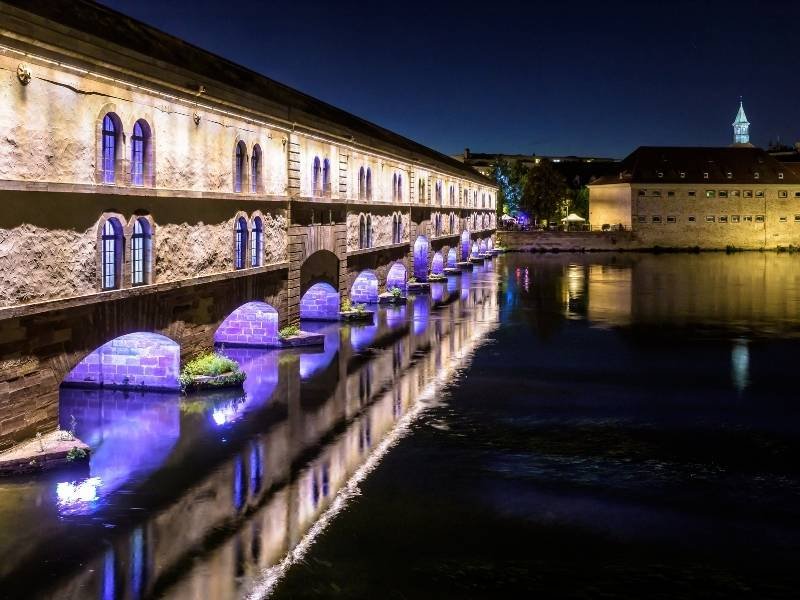
One notable point in history at which Vauban Dam became very useful was during the Franco-Prussian War. It raised the water level of the Ill River; held the Prussians out of the city for a while.
With time, the advancement of technology, and the evolution of warfare, Vauban Dam became obsolete. However, also, with time, it acquired a new purpose—a cultural heritage locals can be proud of, and visitors can marvel at.
And that’s not all! The Vauban Dam also features a lapidarium filled with copies of statues from other notable sites in the city. It’s like a mini tour of Strasbourg, with statues of baby angels, saints, and gargoyles from the Strasbourg Cathedral and Palais Rohan.
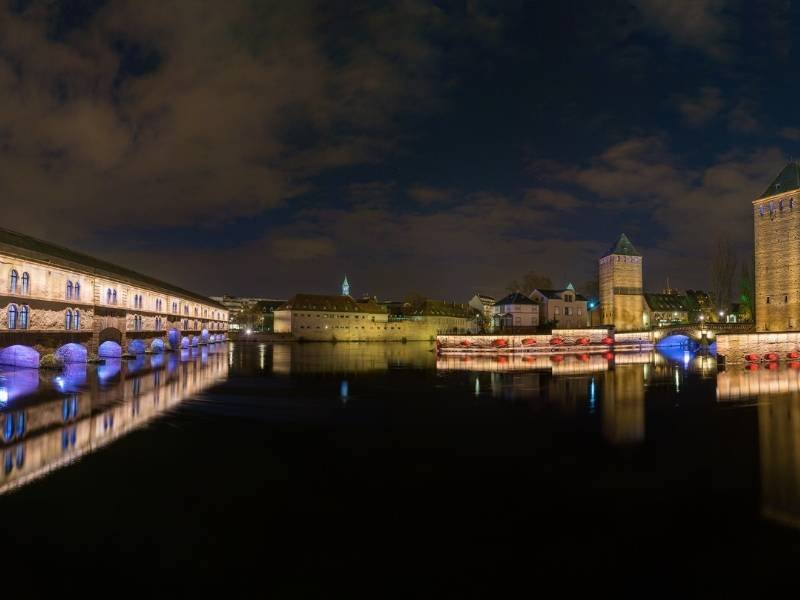
Do you want to go inside Vauban Dam?
Vauban Dam has different opening hours, depending on the season. Admission is free. The last time I checked the official website of the Strasbourg tourism office, Vauban Dam accepts visitors all week:
- May to August: 7:15 am to 9:00 pm
- September to October: 8:00 am to 7:00 pm
- November to February: 8:30 am to 4:00 pm
- March to April: 8:00 am to 7:00 pm
13. Neustadt district
Strasbourg is a city of contrasts, with stunning sights and attractions both within and beyond the Grande Île. Just across the Ill River to the north of this historic center, you’ll find the Neustadt district.
This area is an extension of the city’s UNESCO Heritage site, but it offers a completely different vibe. Instead of the narrow, cobbled lanes of Grande Île, Neustadt boasts wide boulevards and straight, orderly streets.

You won’t find much medieval architecture in the Neustadt district. Instead, it’s a showcase of Art Nouveau and other modern architectural styles like Baroque revival, Renaissance revival, Gothic revival, and Romanesque revival.
This has everything to do with when the district was built and who built it. As the name ‘Neustadt’ suggests, this area was designed to be a new city center, a modern counterpart to the historic Grande Île.
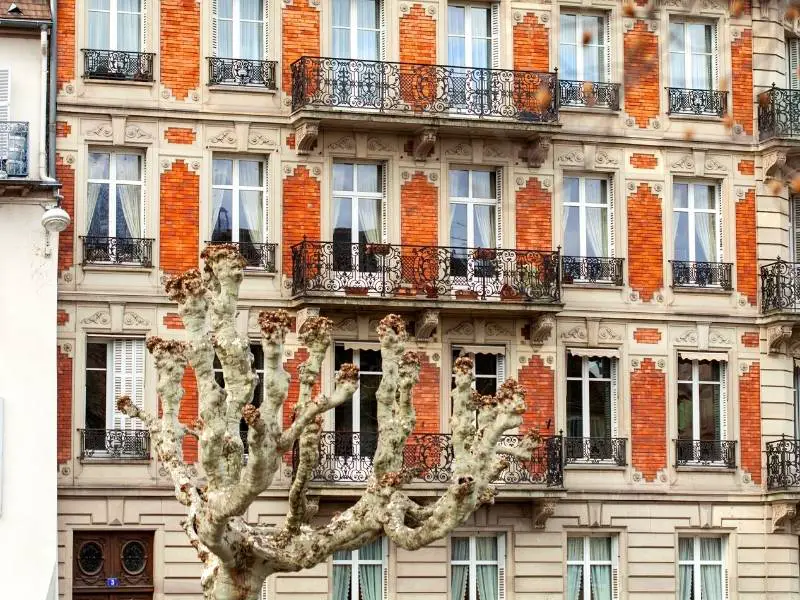
The Neustadt district was constructed by the Germans during their administration from the end of the 19th century to the early 20th century. That’s why I think Neustadt is a compelling reason to visit Strasbourg – it’s unlike any other place in France.
Strasbourg is the French city with the strongest German influence, evident in its architecture and city planning, which follows a Germanic-inspired Haussmannian model. This unique blend of cultures is so distinctive that even UNESCO acknowledges that this urban space is specific to Strasbourg!
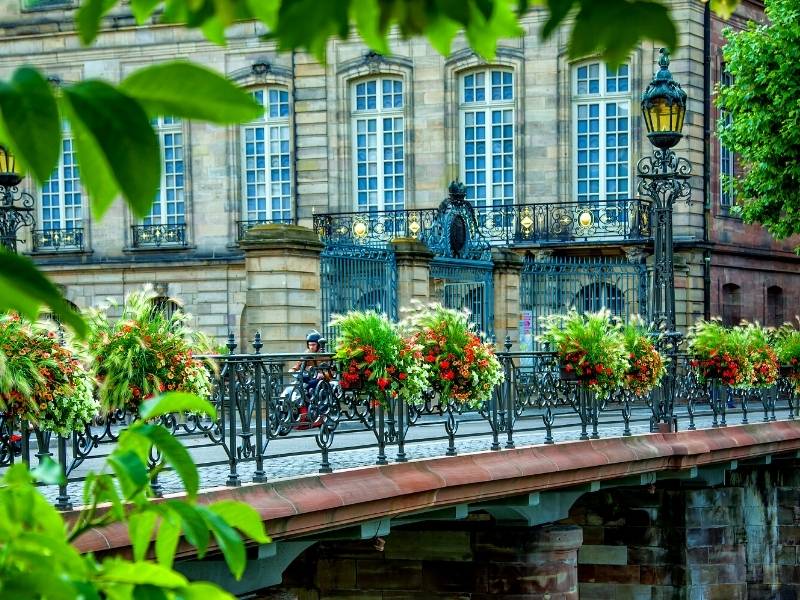
You know what’s really eye-pleasing about the Neustadt district? It’s those grand, elegant buildings with their majestic stone facades. And let’s not forget the ornate black wrought iron window balconies and grills – they add such a graceful touch.
Despite the differences in size, these buildings have a shared aesthetic that creates a pleasing harmony. It’s no wonder architecture buffs and avid travelers find Strasbourg so captivating!
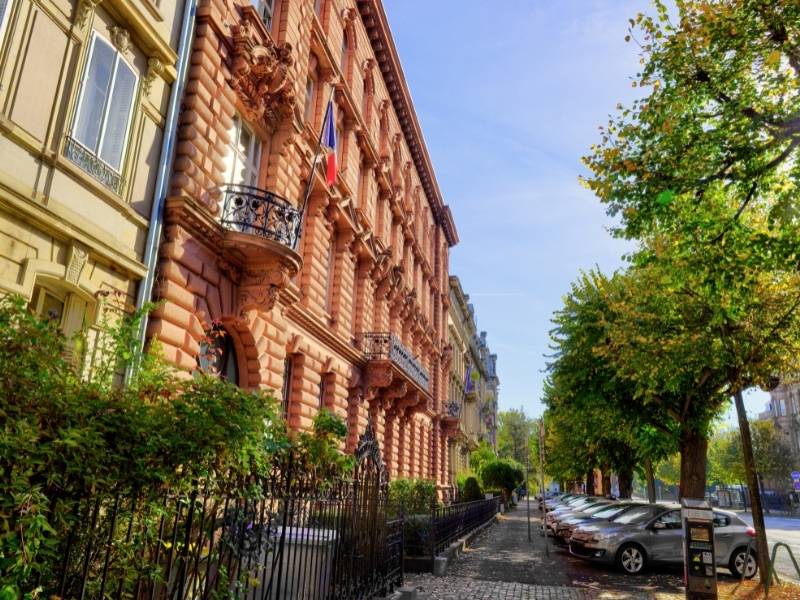
I must mention that some cities in France, like Paris, have also been transformed according to the Haussmannian model. However, nowhere else in France can you find a place similar to Strasbourg’s Neustadt district, which has been uniquely shaped by German influence.
If you come to this district, you will see how this place stands now as a testament to the political, social, and cultural changes that have occurred in the region.
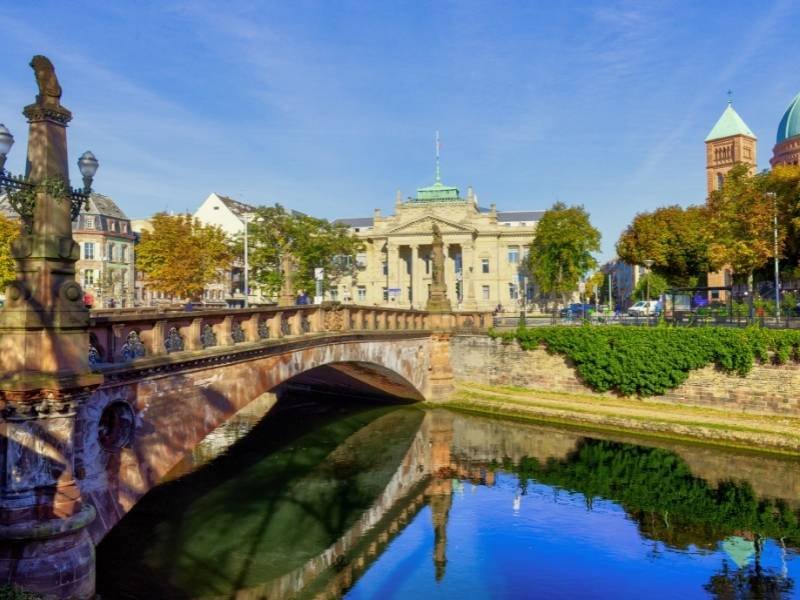
14. Art Nouveau Buildings
When you visit Strasbourg, you’ll feel as though you’re exploring an open museum of architectural styles that represent various cultures and ages. Here, visitors can see how humans have defined architectural beauty through the buildings they’ve created and how the perception of aesthetics has evolved over time.
When the Neustadt district was built, a specific modern art style was flourishing in Europe. This style, known as Art Nouveau, was incorporated into the design of the buildings in the Neustadt district. If you’re interested in discovering art styles that you might not have seen before, the Art Nouveau buildings could be a compelling reason to visit Strasbourg.
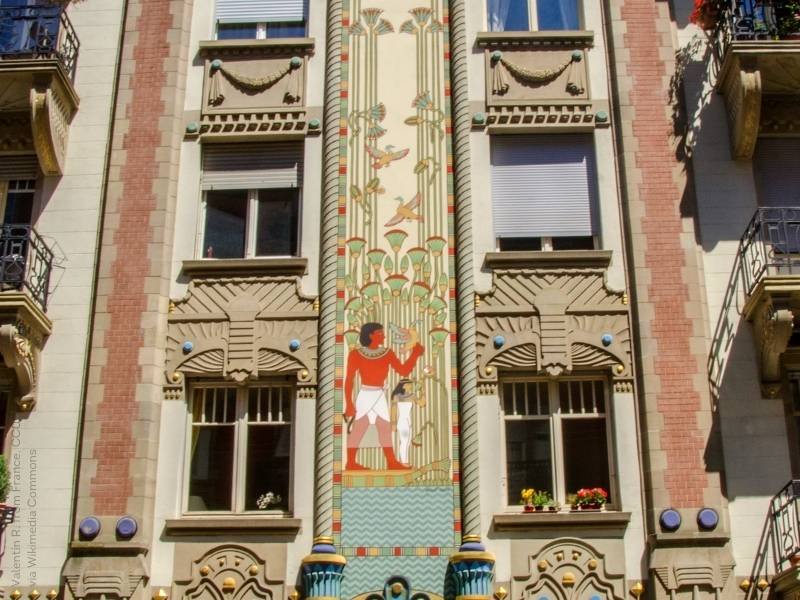
What is Art Nouveau, by the way? Art Nouveau, which translates to ‘New Art’ in English, is an art movement that was intentionally created to replace the eclectic historical styles that were popular at the time. Art Nouveau can be easily distinguished by its characteristics inspired by the natural world. It often features sinuous, curving, arched lines and elements from nature.
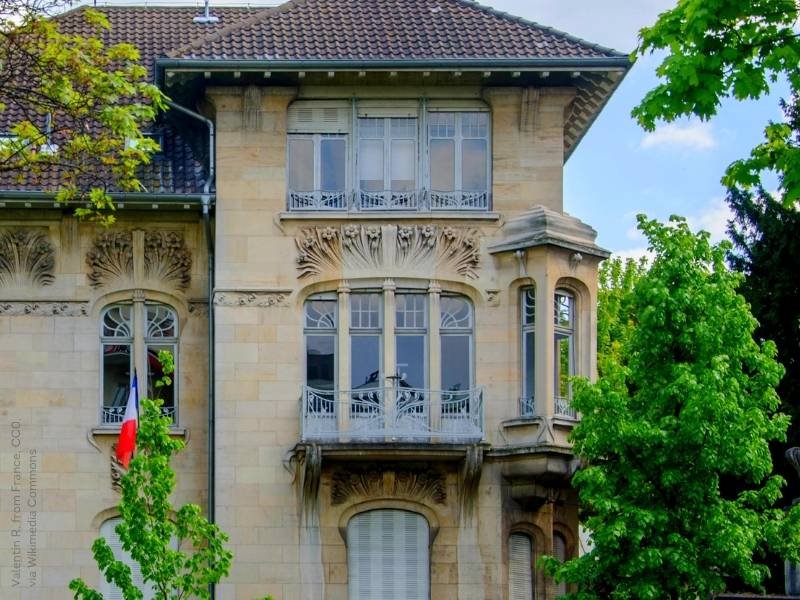
I give you below the exact location of the most impressive Art Nouveau buildings in Strasbourg. This way, you can find and get to each place quicker:
- The Egyptian house
- Villa Brion
- Palais des Fêtes
- #56 in Allée de la Robertsau
- #76 allée de la Robertsau
- #33 Rue des Grandes Arcades (with McDonalds)
15. The Palais Universitaire
Remember when I said that Strasbourg is like an open-air museum of architecture? Well, that’s even more true when you consider all the buildings I’ve mentioned so far, plus one more – the Palais Universitaire.
This grand Neo-Renaissance building in the Neustadt district is a sight to behold. Modeled after a university in Berlin, it’s like a little piece of Germany right in the heart of a city in France. For me, it’s one of those unique landmarks that make Strasbourg a must-visit destination.
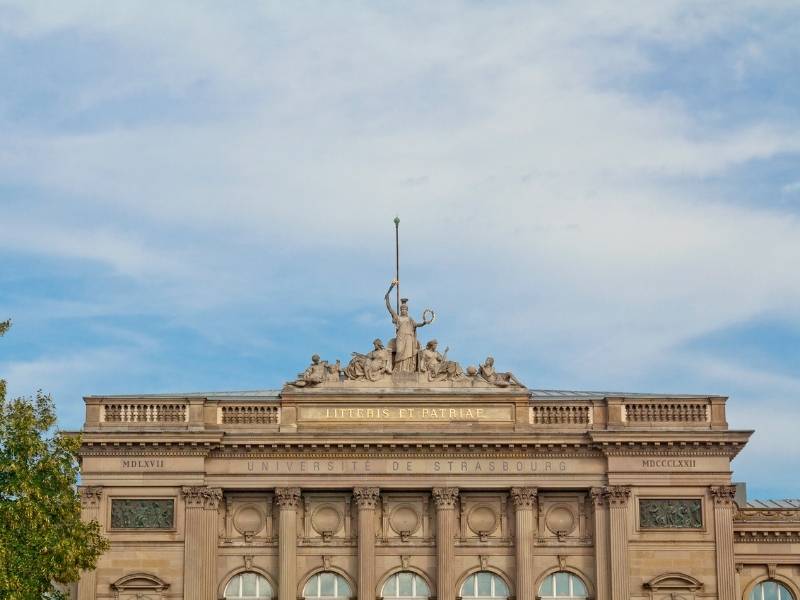
You know what really gives the Palais Universitaire a German vibe?
It’s the 36 sculptures of German scientists, theologians, and scholars that adorn its facades. You’ll find statues of notable figures like Friedrich Carl von Savigny, Immanuel Kant, Johannes Peter Müller, and Carl Friedrich Gauss. But here’s the thing – the Palais Universitaire isn’t just a place to visit if you want to experience a bit of Germany while in France.
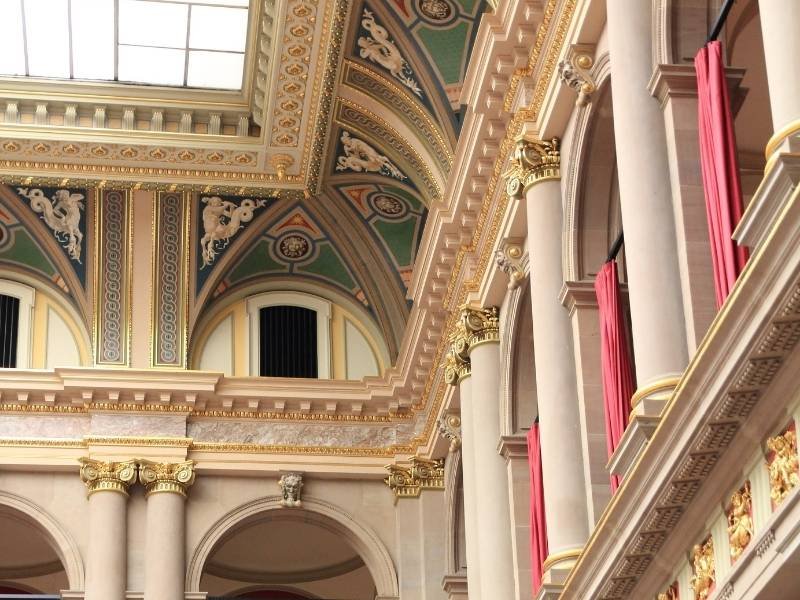
Palais Universitaire has got this incredible architecture, especially the Aula – the great hall. But that’s not all! There’s also this rare artifact, a black granite statue of Ramses II sitting, that’s just begging to be discovered. And if you’re a nature or astronomy lover, you’ll be thrilled to know it has its own botanical garden and a planetarium that replicates a star-filled night sky.
Learn more about Palais Universitaire from its official website.
16. Palais du Rhin
Imagine standing in front of the main facade of the Palais Universitaire. Now, do a 180-degree turn. What you’ll see is Avenue de la Liberté, Strasbourg’s answer to the stunning Avenue des Champs-Élysées in Paris.
It’s arguably the most beautiful avenue in Strasbourg, lined with elegant buildings in the Italian Renaissance style. But the real showstopper? That’s got to be the Palais du Rhin at the eastern end of the avenue. It’s one of those sights that make a trip to Strasbourg totally worth it.
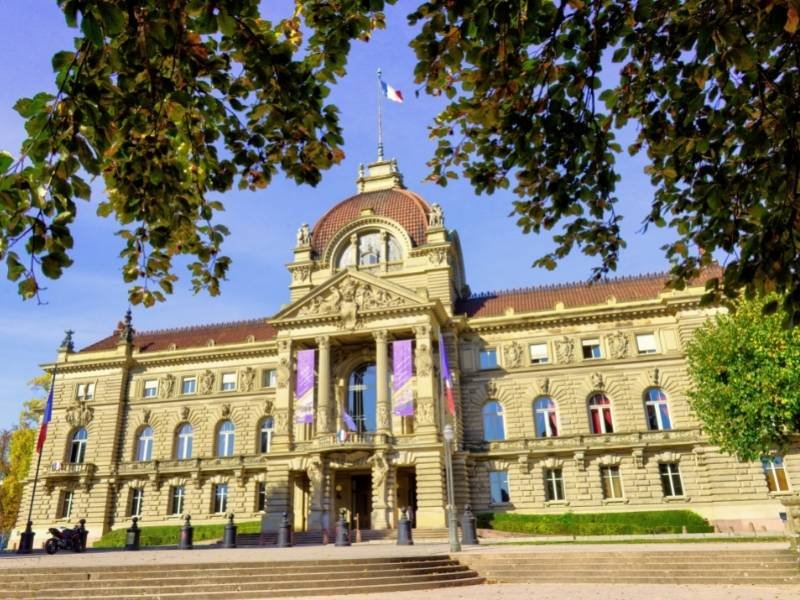
The Palais du Rhin? Oh, it’s the most extravagant and elegant landmark I’ve come across in the Neustadt district. The facade alone is a masterpiece, a perfect example of 19th-century Prussian architecture. If you’ve ever been to Florence, you might find the masonry of the Palais du Rhin reminiscent of the Palazzo Pitti.
But Palais du Rhin is not just a feast for the eyes – this palace is steeped in history too. It was originally built as a residence for the German emperors and hosted seven visits from Emperor William II between its inauguration in 1889 and 1914.
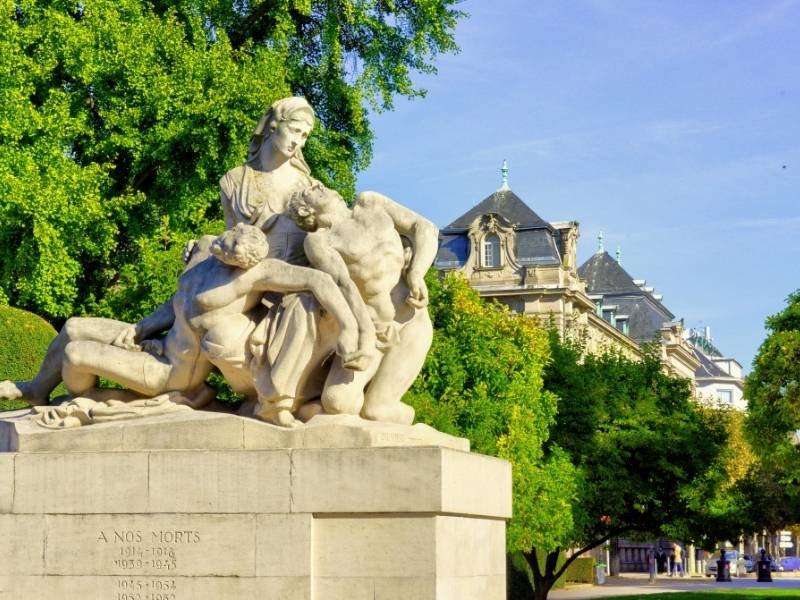
The facade of the Palais du Rhin is a sight to behold, adorned with intricate reliefs and elaborate coats of arms. And let’s not forget the giant sculptures on its tympanum – they’re truly impressive. But the real showstopper? That’s got to be the roof design.
If you’ve got a phone with 10x zoom, you’ll see that the edges of the roof are actually flower sculptures! It’s details like these that make Strasbourg a dream destination for architecture enthusiasts.
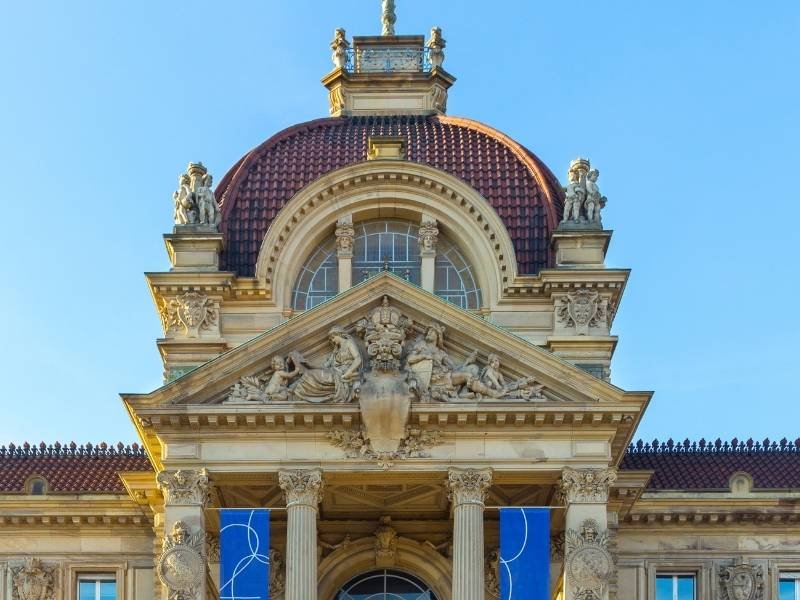
So, you’re wondering if the Palais du Rhin is one of those Instagram-worthy spots in Strasbourg? My answer is a resounding yes! With its stunning architecture and the charming Jardin de la Place de la République out front, it’s a photographer’s dream.
And let’s not forget about springtime – that’s when the cherry blossoms in front of the palace bloom, adding an extra touch of beauty to the scene.
17. European district
Strasbourg isn’t just beautiful, it’s deeply, profoundly beautiful. As the capital of Europe, it’s a living testament to the power of unity and harmony. It shows us that it’s possible for nations and people to let go of past conflicts and live peacefully side by side.
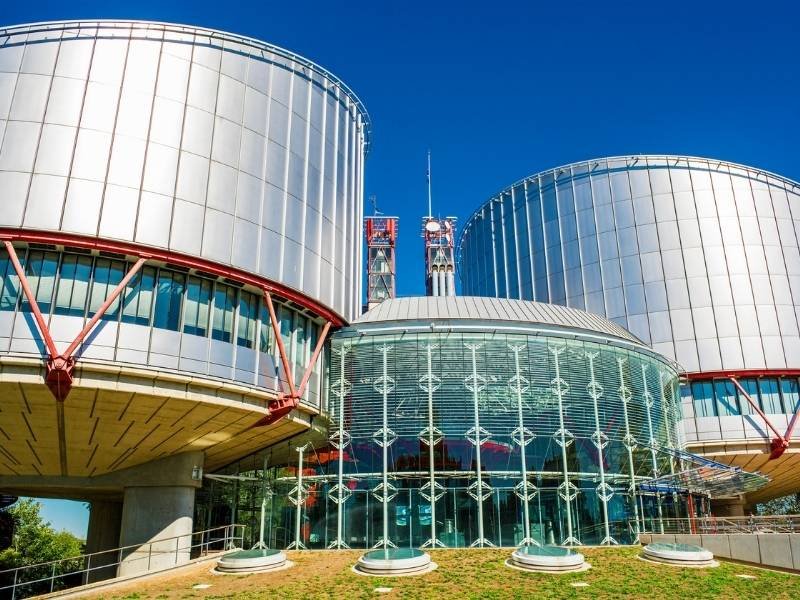
Did you know? Back in 2015, Strasbourg was awarded the European Heritage Label. This isn’t just any award, it’s given to places in Europe that have played a significant role in shaping the Europe we know today.
Cities like Strasbourg, with the European Heritage Label, are all about promoting mutual respect and a shared European identity. The European district is a shining example of the beauty of unity, making it a must-visit spot in Strasbourg.
Plus, it’s home to some pretty futuristic buildings, one of which symbolizes the strength of the European Union. So, if you’re keen to learn more about the European Union, there’s no better place to start!
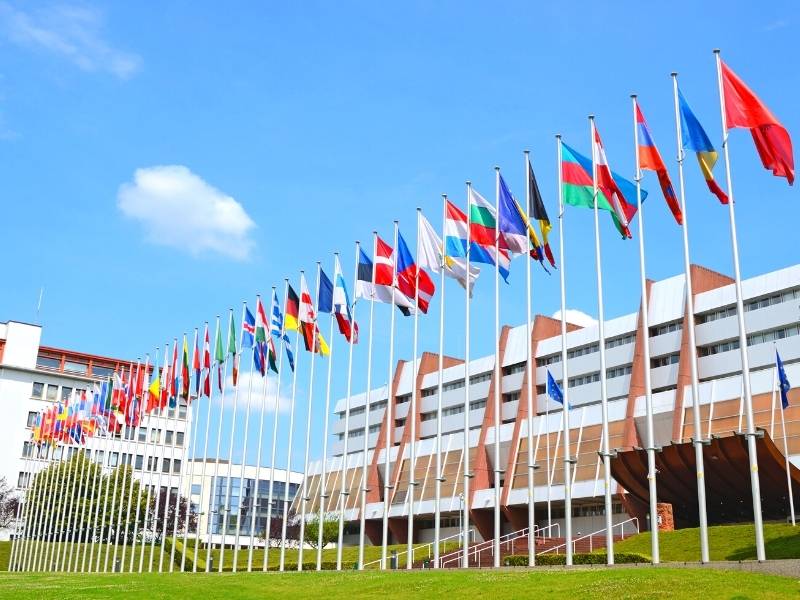
Just like the Grande Île and Neustadt districts, Strasbourg’s European district is packed with attractions. If you start your journey in Grande Île and end in the European district – it’s like a time travel adventure from the medieval ages to the present!
I’ve found eight spots in the European district that you might want to check out. They’re architectural wonders that house various institutions of the European Union. Here’s a quick rundown:
- Lieu d’Europe – A place where you can immerse yourself in European values and institutions.
- European Court of Human Rights – This stunning building, designed by British architect Lord Richard Rogers (who also designed the Georges Pompidou Center in Paris), resembles the Scales of Justice.
- European Parliament – Arguably the most elegant building in the district. Its tower was intentionally left unfinished to symbolize the ongoing construction of the European Union.
- ARTE – The picturesque headquarters of Association Relative à la Télévision Européenne, located beside the Ill River, is a testament to successful French-German cooperation.
- European Ombudsman – This is where businesses and individuals can seek help against maladministration by some bodies of the European Union. The building itself boasts futuristic architecture.
- Palais de l’Europe – Home to the Council of Europe, the oldest intergovernmental organization in Europe. Outside, you’ll find flags representing its 47 member states.
- Agora – A marvel of modern architecture that was voted Best Office Building of The Year in 2008. It’s also the Council of Europe’s newest building.
- European Directory for the Quality of Medicines in Healthcare – This building, with its curved glass and wooden structure, bears a striking resemblance to the European Parliament building and showcases modern aesthetics.
I’ve linked their exact locations for you, just in case you want to see them for yourself! If you’re looking for more details about these spots, check out the website of a non-profit organization called Europe Direct Information Center. They’ve got a route all mapped out for you if you want to see everything.
Out of the eight places I mentioned, the European Parliament is a real standout. But more on that in a bit. Let’s keep going!
18. The European Parliament
The European Parliament is more than just an attraction in Strasbourg’s European district – it’s a place that welcomes everyone, tourists and locals alike. It stands out among other landmarks for its educational value and impressive architecture.
Located on the banks of the Ill River in the northeastern part of the city, it offers some truly breathtaking views. Whether you’re on a boat ride or standing on the riverbanks southeast of the building, you’re in for a treat. And if you visit when the weather is just right and the Ill River is calm, you’ll see it reflected on the water.
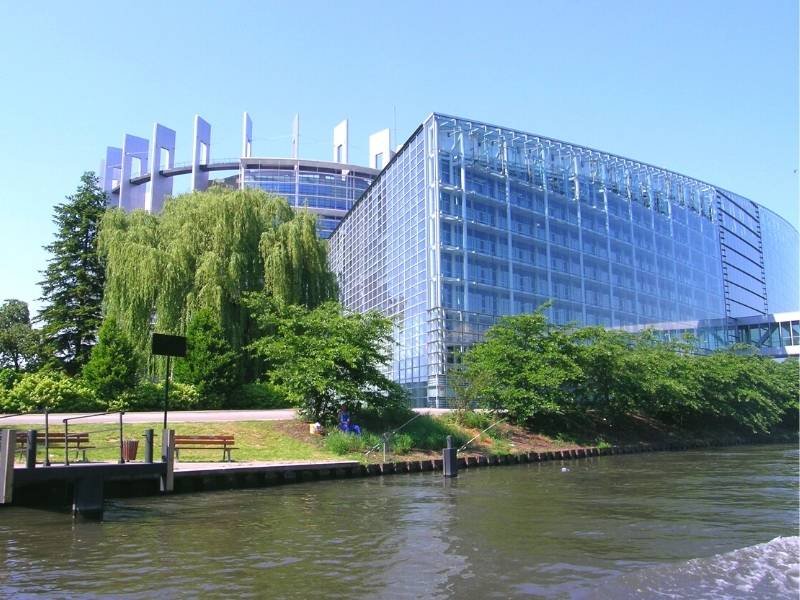
For me, the European Parliament is a big part of what makes Strasbourg worth a visit. Its striking modern architecture and educational value are impressive enough, but it’s also a place of historical significance. This is where decisions about Europe’s future are made – talk about being at the heart of the action!
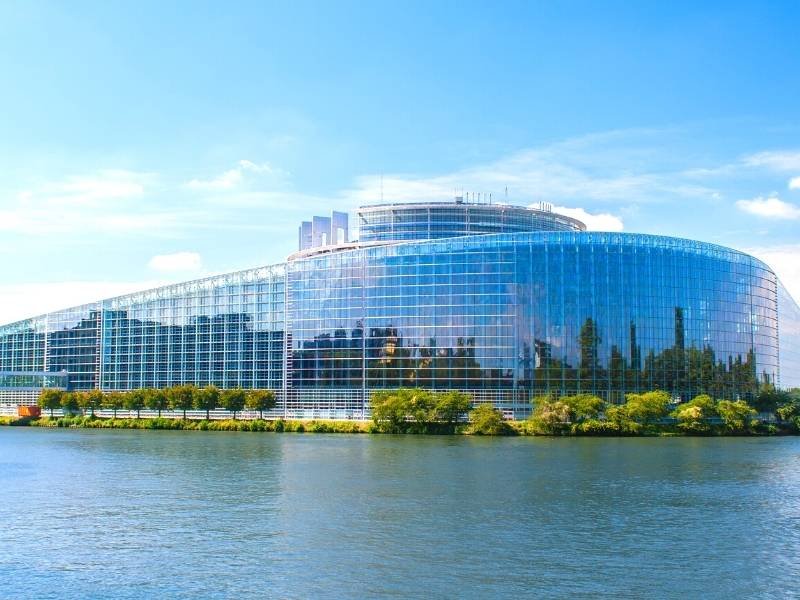
You can check these videos created by the European Parliament to learn further. Here’s a very brief introduction to the EU parliament:
Then here’s a comprehensive video showing the experiences awaiting you in the European Parliament in Strasbourg:
It might not come as a surprise, but the European Parliament holds the title for being the world’s largest transnational parliament. But there’s more. The Strasbourg-based European Parliament also houses the Parlamentarium Simone Veil, the largest parliamentary visitor center.
Can you believe it’s had more than 2 million visitors since it was built? It’s a great spot for teens and adults alike, with interactive exhibitions that shed light on the work of parliament members, the institution’s role, and different political groups.
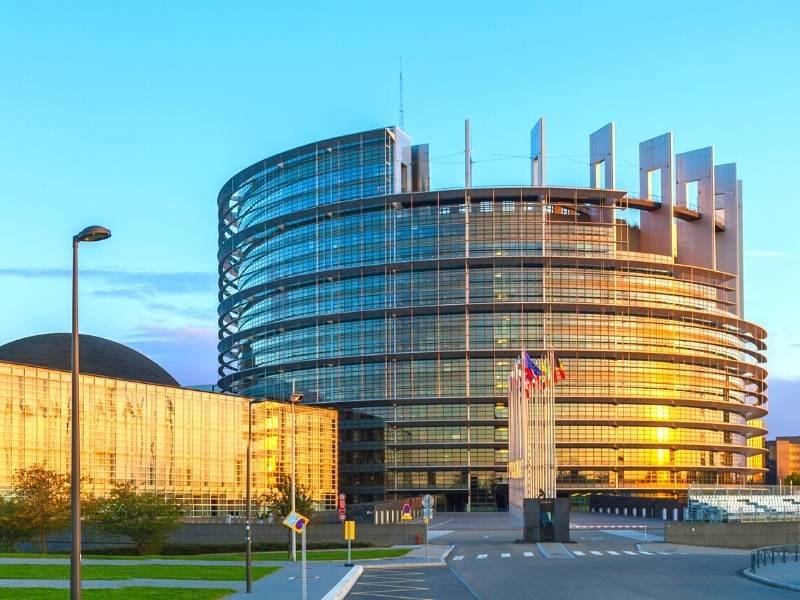
You can explore the European Parliament in Strasbourg without any guides Monday to Friday from 1:00 pm to 5:00 pm and 09:30 to 5:00 pm every Saturday (lunchtime from 12:00 pm to 1:00 pm). You can learn more visiting information by booking group tours from the official website of the European Parliament.
19. Little Gems in Strasbourg
So, we’ve talked about all the amazing places you can visit in Strasbourg, right? But here’s a little secret: as you’re wandering around, you might stumble upon some hidden treasures. I like to call them the “Little Gems” of Strasbourg.
They might not be as grand as the Strasbourg Cathedral or as quaint as the houses in Petite France, but they’ve got a charm all their own. And trust me, these gems are worth the trip to Strasbourg. Want to know why? Let’s dive in!
Let’s kick things off with something that really made me stop and think in Strasbourg. It’s called the Vault for the Future, or Caveau du Futur in French. This vault is one of the most unusual you’ll find, not just in Strasbourg, but maybe in all of France. It might not catch your eye at first, but once you read what’s embossed on it, it’ll blow your mind!
Here’s the preview:
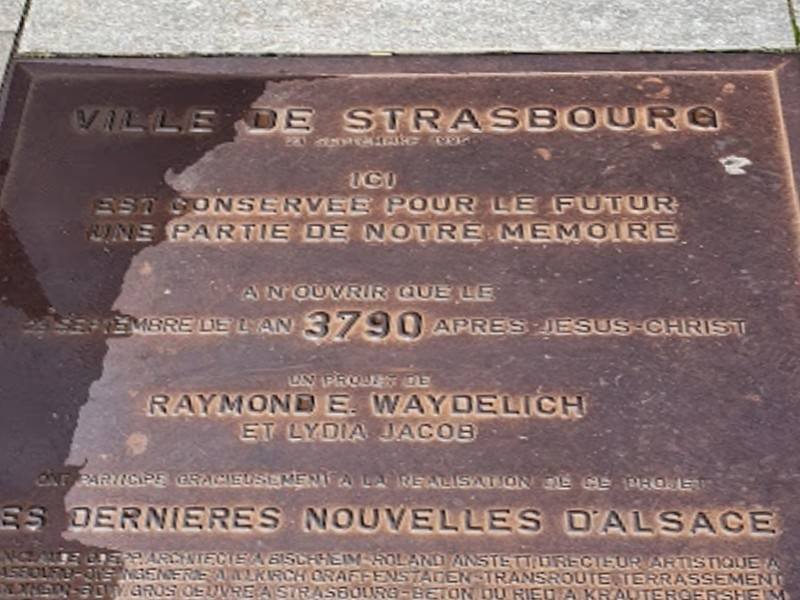
Yes, it’s in French. If you’re like me and only speak two languages, neither of which is French, it might not make much sense at first. But once I translated it, here’s what I found out:
“This is preserved for the future”
“A part of our memory”
“To be opened on the 23rd of September 3790.”
It was sealed by the owner in 1995. And according to the tourism office of Strasbourg, it contains computers, medical documentation, and holy books of the residents. I wonder if there are refrigerators inside because they say the vault also has beers, wines, and even pretzels! Caveau du Futur is really strange. And, it makes me wonder why we should only open it in 3790…
You can find Caveau du Futur in the Place du Château Square. It should be only a few steps away in front of the southeast portal of the Strasbourg cathedral.
There’s another quirky landmark in Strasbourg that’s worth checking out. It’s an outdoor sculpture called Woman Walking to The Sky, located near the memorial for the synagogue that was destroyed by the Nazis. As you’re wandering around, it’s sure to catch your eye – it looks just like a real woman walking up an inclined pole!
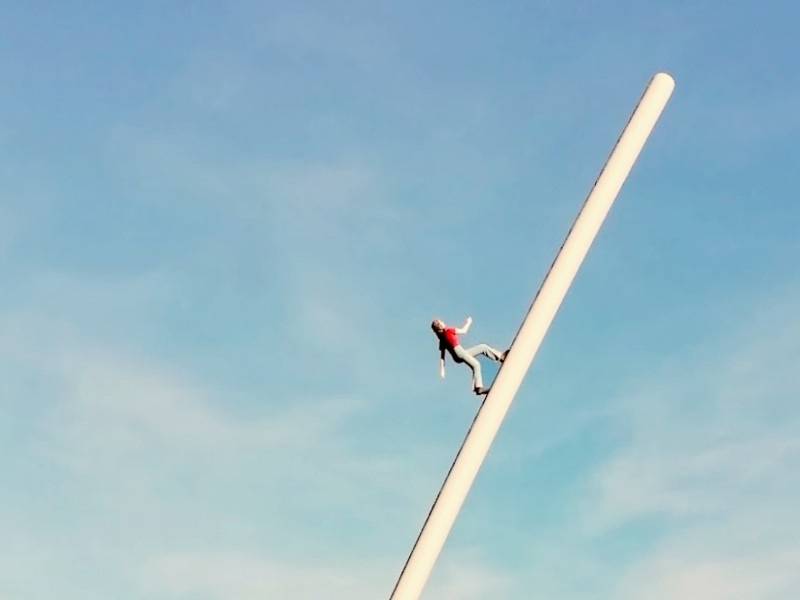
If you find yourself in the European District, make sure to take a detour to the gardens of the European Court of Human Rights. Why, you ask? Well, there’s a piece of the Berlin Wall waiting for you there! You’ll find four fragments of the wall right near the main entrance of the building.
And while we’re on the topic of Germany, there’s another gem in Strasbourg that ties back to it – the Fountain of Janus. This fountain, with its two-faced man, symbolizes Strasbourg’s unique Franco-German identity. You’ll find it right next to the Théâtre Alsacien de Strasbourg.
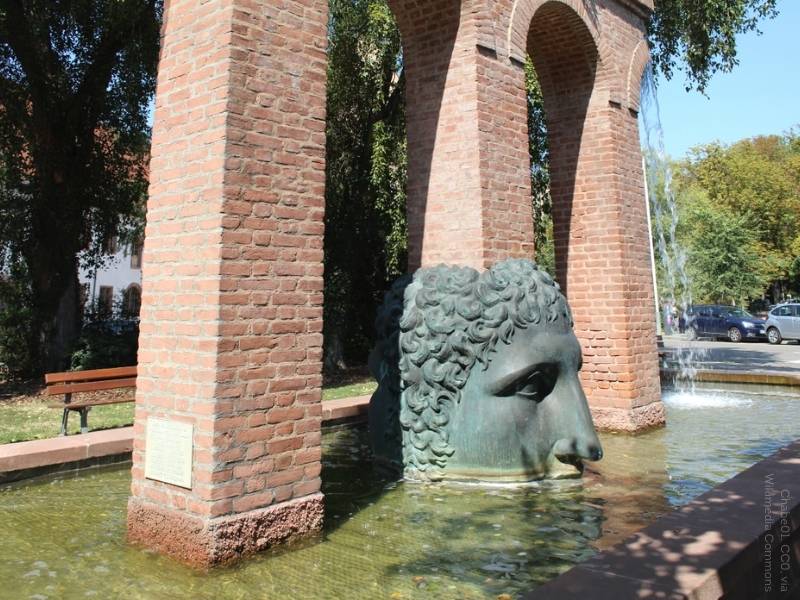
When you’re visiting the Neustadt district, do yourself a favor and stroll along Pont Royal or catch a tram to the Gallia Tram stop. Trust me, you won’t regret it! This bridge offers an amazing view of Église réformée Saint-Paul that’s just begging to be shared on Instagram. From Pont Royal, it almost looks like the church is floating on the river!
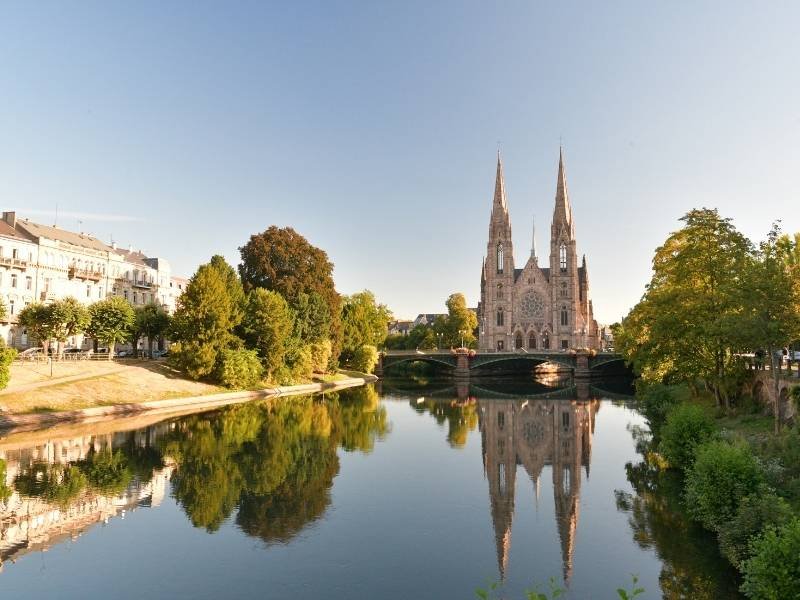
Speaking of churches. Do you know that there is an elegant Russian Orthodox Church in Strasbourg? Its white facade and the pale-green curvy roof are very eye-catching! The Russian Orthodox Church sits by the riverbank near the Rhone River, on the outskirt’s northeast of the city. It appears magical when looking at it from the other side of the river or while riding a boat.
swipe the 360° image below to see more views
Like Strasbourg, Lyon is another city in France that’s just packed with delightful discoveries. Think massive murals, maze-like Traboules, and of course, the cuisine! Check it out!
20. Vodou Museum
If you’re up for a unique, spooky, but totally fascinating experience, then Strasbourg has got you covered! And no, it’s not about European witches or magic, but something from Africa.
Just a 2-minute walk from Porte Blanche station near the central train station, you’ll find the Vodou Museum. This place is home to the world’s largest private collection of West African voodoo artifacts – we’re talking over 1000 items! Get ready to dive deep into an ancient belief system and a captivating culture that’s still alive and well today.
Voodoo might not be everyone’s cup of tea, but it sure does make for an intriguing discovery! It could be the unexpected “twist” in your Strasbourg travel tale. Amidst a city brimming with charm, medieval allure, elegance, and modernity, stumbling upon something as unique as voodoo is quite the surprise.
The Vodou Museum is home to some of the most peculiar objects used in West African religious practices. From items used in medicine and ancestor worship to those used in witchcraft and divination, it’s a fascinating yet somewhat eerie collection.
According to the museum’s official website, these voodoo artifacts hail from places like Togo, Nigeria, Ghana, and Benin. For me, the standout is the permanent exhibition, “Vodou: the art of seeing differently.” So yes, the Vodou Museum definitely qualifies as one of Strasbourg’s hidden gems (as mentioned in the previous section).
The Vodou Museum is housed in a striking octagonal water tower that’s a marvel of architecture. Its metal latticework and geometric windows are what really catch the eye. The museum is open from Tuesday to Sunday, between 2:00 pm and 6:00 pm. Tickets are priced at 14 EUR for adults, and you’ll need to book in advance from the 9th of June.
Learn more visiting information from the official website of the Vodou Museum.
21. Alsatian Museum
Earlier, we talked about how you can explore a unique slice of African culture right in the heart of Strasbourg at the Vodou Museum. But did you know there’s also a museum dedicated to the region where Strasbourg is the capital? It’s called the Alsatian Museum.
This place gives you a peek into what life is like for the people of Alsace, the region where Strasbourg is the capital. The museum is housed in three former Alsatian homes, so it feels like you’re stepping into a local’s living room rather than a traditional museum.
Housed within some quaint houses on Quai Saint-Nicolas, you’ll find the Alsatian Museum. It’s home to more than 5000 artifacts from ordinary Alsatian life, spread out over 30 rooms. From furniture and toys to traditional costumes and tools, it’s a fascinating snapshot of local life.
If you’re a slow traveler who loves to delve into the details, this museum is definitely worth a visit. Discovering the little things and immersing yourself in the stories of the residents is a great way to learn and expand your understanding, wouldn’t you agree?
A visit to the Alsatian Museum is like a journey through time. With collections from the 18th and 19th centuries, you’ll get to learn about the Alsatian Jews and what rural life was like back then. The museum is open from 10:00 am to 6:00 pm every day, except for Tuesdays.
Check the website of Strasbourg museums to learn more about visiting information.
22. Plenty of Daytrips & Nearby Attractions
One of the best things about Strasbourg is its strategic location. It’s not just a gateway to some of the most beautiful places in France and Germany, but also to Switzerland.
Let’s start with France. If you’re already in Strasbourg, you don’t have to go far to find a real-life fairytale destination. Hop on a train, and in less than 30 minutes, you’ll be in Colmar.
This charming town is filled with timber-framed houses and is so picturesque that it was replicated in Malaysia, halfway around the world! Plus, Colmar is surrounded by mountain-top castles, making it the perfect place for an unforgettable escape. Learn more about Colmar here.
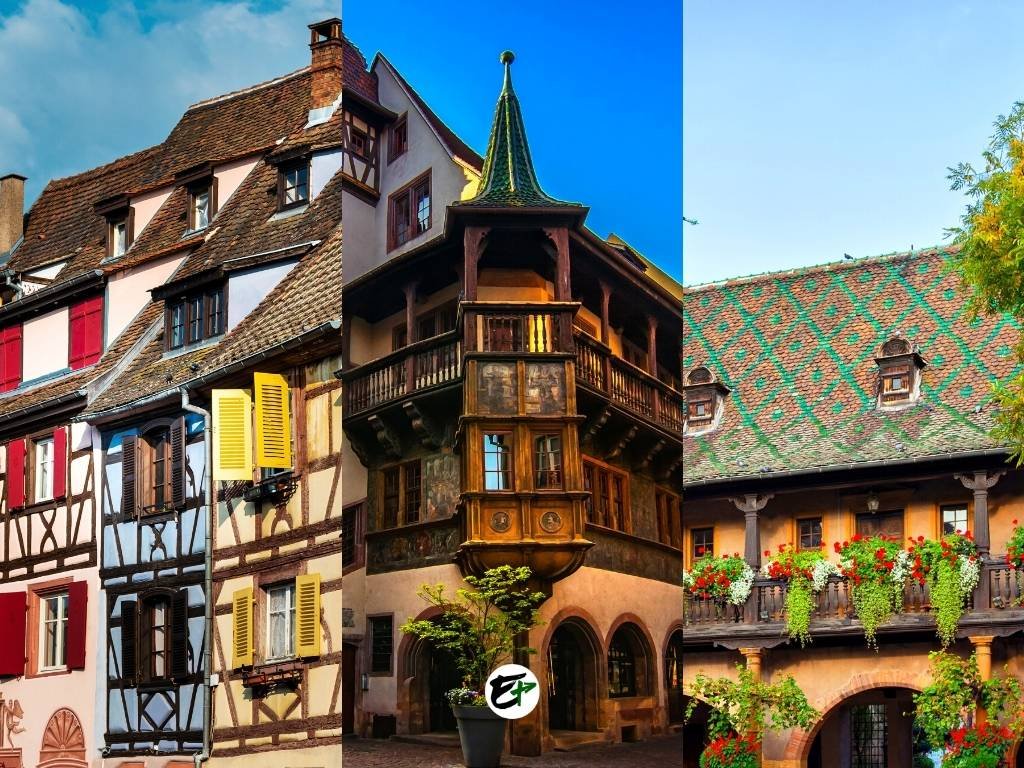
Colmar is situated to the south of Strasbourg, but if you keep heading south, you’ll find yourself in Switzerland – the heart of the Alps and one of Europe’s most picturesque spots. There’s so much to see and do here, especially if you’re looking for a dose of awe-inspiring beauty!
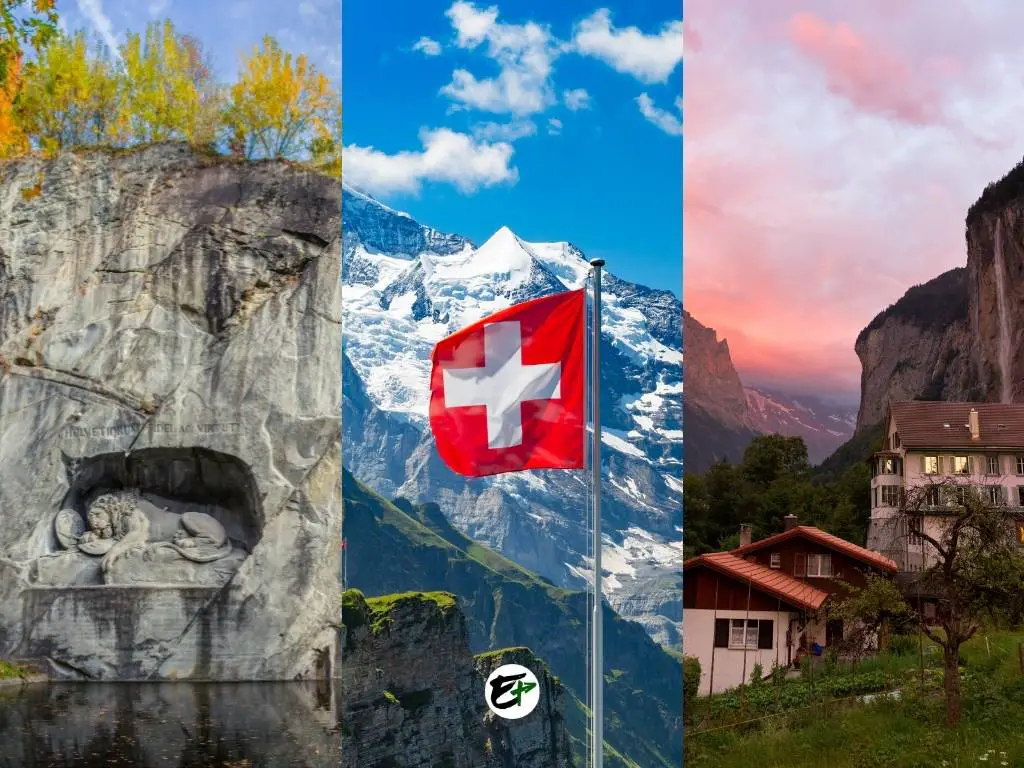
You can check my Switzerland itinerary to see how amazing this country is. Among the destinations in Switzerland, I recommend that you see Lucerne, Zermatt, and the tourist attractions in the Jungfrau Region (Lauterbrunnen, Grindelwald, Interlaken).
But guess what? You don’t have to venture all the way south to Switzerland for jaw-dropping scenery. The Black Forest in Germany is just a stone’s throw away from Strasbourg. Seriously, all you have to do is cross the Rhine River and you’re there!
The Black Forest is a magical blend of stunning landscapes and enchanting spots, much like Petite France or Colmar. And it’s got its fair share of unique finds too, like the world’s largest cuckoo clock!
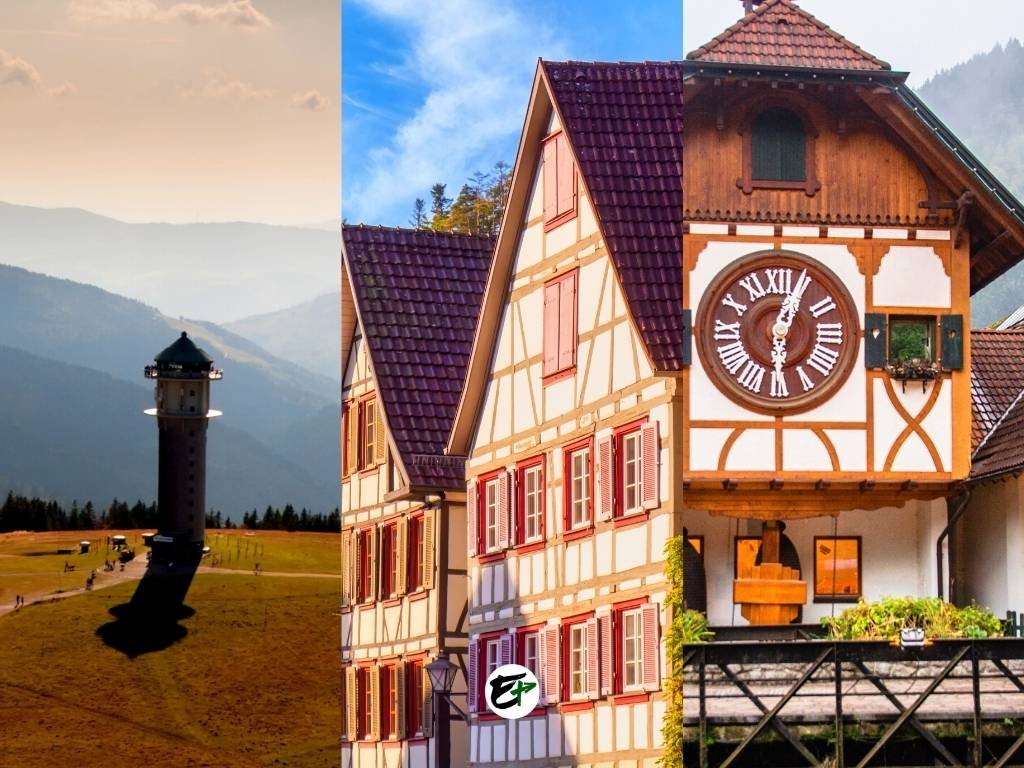
If you make it to the Black Forest, you can continue eastward and start exploring southern Germany and Bavarian Alps. These places are packed with stunning scenery, too and cute Lüftlmalerei houses. Here, I give you a list of the most beautiful places in Southern Germany or the Bavarian Alps itinerary to learn more.
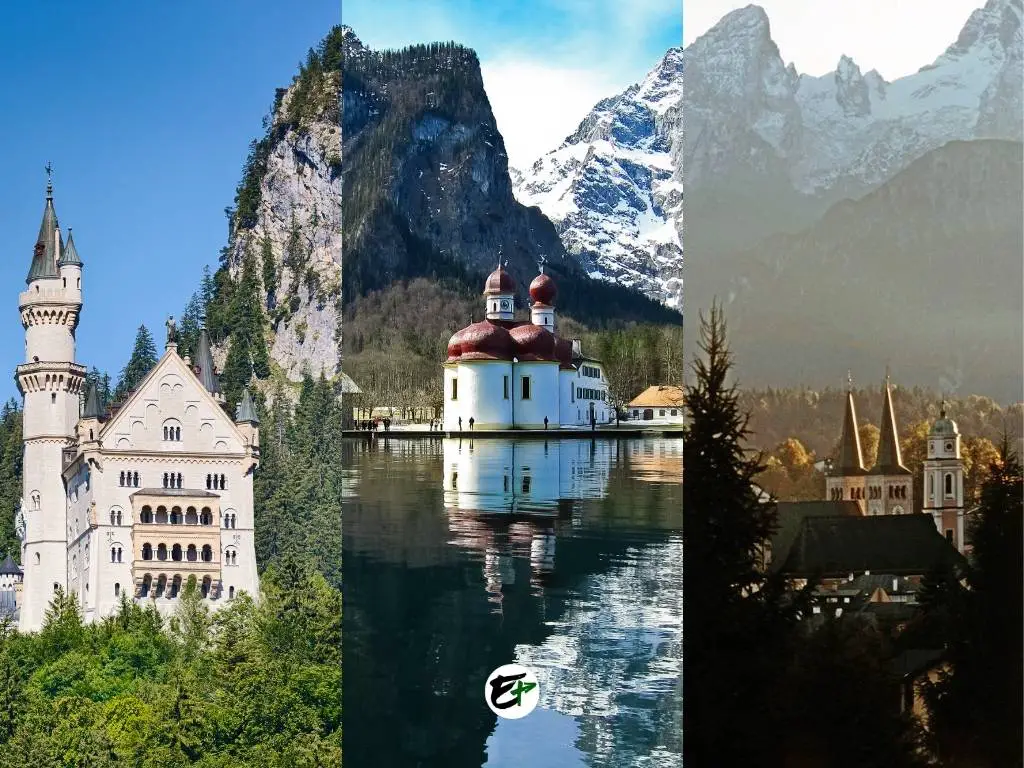
Interested in seeing more beautiful places in France? Try the charming alpine town of Annecy or the 10 most beautiful villages in the South of France:
- Gordes — a beautiful village on a hilltop in the Luberon region. It has stone houses, a castle and a great view.
- Eze — an old village on a peak above the sea. It has a garden, a perfume factory and a church with a special mosaic.
- Rocamadour — a holy place on a cliff over a canyon. It has many religious buildings, a statue of the Black Madonna and a forest with monkeys.
- Moustiers-Sainte-Marie — a lovely village between two cliffs. It is famous for its pottery, its star hanging in the sky and its closeness to the Verdon Gorge.
- Aigues-Mortes — a city with walls around it in the middle of salt marshes and lagoons. It has medieval towers and gates, and a history of crusades and salt making.
- Carcassonne — an amazing town with walls around it that is protected by UNESCO. It has a big castle, a basilica and a canal.
- Chamonix — a ski resort at the bottom of Mont Blanc, the highest mountain in Western Europe. It has wonderful scenery, outdoor activities and cultural events.
- Domme — a town on a plateau over the Dordogne river. It has a view of the valley, a Gothic church, caves and a prison for the Templars.
- Saint Paul De Vence — a village that many artists, writers and celebrities liked. It has walls around it, art galleries, museums and fountains.
- Saint-Cirq-Lapopie — is one of the most beautiful villages in France, on a cliff over the Lot river. It has medieval houses, workshops and churches.
How Many Days in Strasbourg
I hope I’ve provided you with plenty of inspiration about the marvels of Strasbourg! Does this have you considering a trip?
Well, two days should cover the main sights of Strasbourg. You’ll have time to check out the Grand-Île de Strasbourg, hit up a museum, and maybe even do a wine-tasting. But here’s a tip: Strasbourg is a great home base for exploring the area. So if you can swing it, consider spending a third day on a day trip.
Now, if you’re lucky enough to have three days or more, you can venture beyond the city center. Check out the European institutional buildings, take a vineyard tour, or visit another Alsatian town like Colmar.
How to Get to Strasbourg
There are three ways you can reach Strasbourg. By plane, train, or by road.
If you’re in France, you can hop on a plane and be in Strasbourg in less than 2 hours.
Are you from other European country? it might be quicker to fly into a big hub like Paris or Frankfurt, and then catch a train to Strasbourg. If you’re starting from Paris or near by German towns, there are direct trains to Strasbourg that’ll get you there in under two hours. The French TGV trains and the German ICE trains are super fast and run frequently to Strasbourg.
If you’re up for a road trip, you can drive from Paris or Lyon to Strasbourg in about 4:30 hours. To give you perspective, here’s the time you’ll need to reach Strasbourg from nearby cities:
-
France
- Paris: You can take a direct train from Paris to Strasbourg in under two hours.
- Lyon: Lyon is about 4:30 hours away from Strasbourg by land.
-
Germany
- Karlsruhe: You can take a train from Karlsruhe Hauptbahnhof to Strasbourg.
- Frankfurt: The journey from Frankfurt to Strasbourg takes approximately 1 hour and 48 minutes by train.
-
Switzerland
- Zürich: You can take a train from Zürich to Strasbourg via Zürich HB and Basel Sbb in around 2 hours and 39 minutes.
- Basel: The train journey from Basel to Strasbourg is around 1 hour and 18 minutes.
When to Visit Strasbourg
If you’re all about that holiday magic, winter is a great time to visit Strasbourg.
The city is famous for its huge traditional Christmas markets. But if you’re more of a sunshine and outdoorsy type, you might prefer late spring or summer. You can enjoy dining outside and river cruises.
Now, if you’re looking to dodge the crowds but still want decent weather, consider visiting in the spring (April to June) or fall (September to November). These seasons are less busy and the weather is usually mild, perfect for outdoor activities and day trips.
For an unforgettable experience in Strasbourg, consider timing your visit to coincide with the city’s cultural events:
- European Fantastic Film Festival (September): This is a big deal for fans of fantastic cinema. It’s one of the top genre events in Europe and features everything from thrillers and noir films to video games and virtual-reality cinema. Plus, they’re big on film revivals, so it’s a great chance to catch some classics.
- Jazzdor (November): If you’re into jazz, you’ll love Jazzdor. They host two annual festivals in Strasbourg and Berlin, as well as a season of concerts. It’s a great chance to catch some of the best international jazz acts.
- Musica (September to October): This is a must for contemporary music fans. Musica brings together leading composers, musicians, and young talent for a series of performances.
- The Architecture Days (September to October): This event is all about celebrating architecture in all its forms. It’s a unique collaboration between France, Switzerland, and Germany.
- St’art (November): Art lovers, this one’s for you. St’art Strasbourg is one of the first contemporary art and design fairs in the region and attracts thousands of visitors every year.
- Strasbulles (October): If you’re into comics, you’ll want to check out Strasbulles. It’s a free event where writers, cartoonists, scriptwriters, and colorists get together with fans.
- Ososphère (October): This festival is all about digital cultures in the city. They host electronic nights, exhibitions, artistic tours, projections, concerts, sound cruises, workshops, conversations, radio.
- Augenblick Festival (November): This festival celebrates the best of German-language cinema and promotes Franco-German bilingualism.
Discover more events from the Strasbourg Tourism Office’s Calendar.
Where to Stay in Strasbourg
Is it your first time in Strasbourg? You might want to check out Petite France. If you stay here, you can easily explore the historic heart of the city, complete with canals and medieval houses. There’s a range of accommodations from budget to high-end.
If you’re into nightlife, Krutenau is your spot. It’s a hip neighborhood with a student vibe, lots of bars, pubs, and live music. You’ll find everything from hostels to apartments here.
If you’re visiting during Christmas, you’ll want to stay in Carré d’Or. This shopping district is home to the famous Christmas market at Place Kléber and the Strasbourg Cathedral. Accommodations range from aparthotels to luxury hotels.
If you’re just passing through or on a business trip, Quartier de la Gare near the train station might be your best bet. It’s super convenient for public transport and getting to the city center. There are plenty of budget and mid-range chain hotels in this area.
If you’re still looking for a place to stay, here’s a resource that can help you find the best hotel deals in Strasbourg. It includes a handy map feature, so you can choose a hotel in the most convenient location for you.
Guides in Visiting Strasbourg
Hey there! I hope you found my Strasbourg article helpful.
I hope it’s given you some clarity on whether or not to include this incredible city in your travel plans. If you’re now keen to go but aren’t a fan of planning or simply don’t have the time, don’t sweat it—I’ve got you covered!
I’ve teamed up with one of the most reputable travel and tour companies in Europe to take care of that for you. Check out the list below for my top recommended deals. And if you’re only in Strasbourg for a day, make sure to hop on that boat ride—it’s a must!
Have a great trip to Strasbourg! 🙂
Save it on Pinterest.

